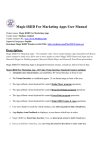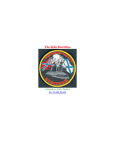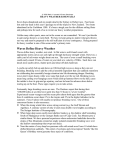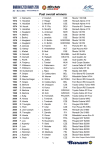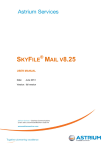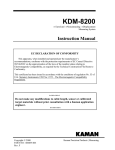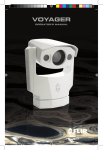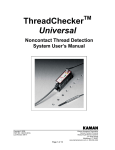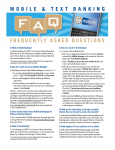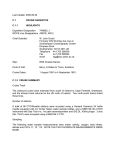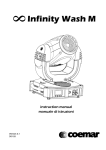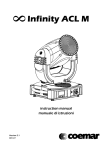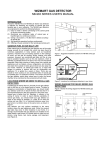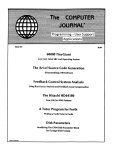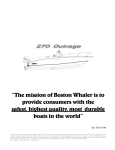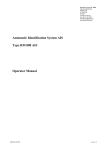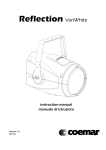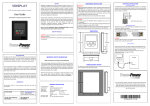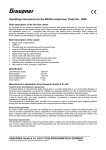Download View/Open - Calhoun: The NPS
Transcript
iOOfe
NAVAL POSTGRADUATE SCHOOL
Monterey, California
f^uf^-?/)
AN INTELLIGENT COMPUTER-AIDED
INSTRUCTION SYSTEM
FOR NAVAL SHIP RECOGNITION
by
Denise R. Bemier
June 1989
Thesis Advisor:
Approved
Neil C.
Rowe
for public release; distribution unlimited
mh^Jjti.i-
POSrO-Hi.
MOiJl'EEEY, CALIi
-SCHOOL
Uiii^ iii
9394&-6002
Jnclassified
security Classification of this
page
REPORT DOCUMENTATION PAGE
Markings
lb
Restrictive
3
Distribution Availability of Report
Rqx)rt Security Classification
a
UNCLASSIFIED
Security Classification Authority
Ja
Approved for public
Declassification/Downgrading Schedule
3b
Performing Organization Report Number(s)
I
Name of Performing
id
6b Office Symbol
Organization
release; distribution is unlimited.
5
Monitoring Organization Report Nuinber(s)
7a
Name of Monitoring Organization
7b
Address
(If Applicable)
52
Naval Postgraduate School
c Address (city,
v^onterey,
state,
Naval Postgraduate School
and ZIP code)
CA 93943-5000
Name
la
(city, state,
of Funding/Sponsoring OrganLzation
8b Office Symbol
and ZIP code)
CA 93943-5000
Monterey,
Procurement Instrument Identification Nimiber
9
(If Applicable)
Address
'c
(city, state,
and TIP code)
Source of Funding Numbers
10
Program Elonent Number
Project
No
T»sk No
Work
Unit Accession
No
Title (Include Security Classification)
1
iiN
INTELLIGENT COMPUTER-AIDED INSTRUCTION SYSTEM FOR
2
Personal Author(s)
NAVAL SHIP RECOGNmON
Bemier, Denise R.
Type of Report
3a
Supplementary Notation
6
)olicy
Date of Report (year, month,day)
14
To
The views expressed
Codes
Group
ield
From
in this
15
Page Count
June 1989
97
thesis are those of the author and do not reflect the
official
or position of the Department of Defense or the U.S. Government.
Cosati
7
Time Covered
13b
Master's Thesis
Subject
18
Terms (continue on reverse
if necessary
Artificial Intelligence, Intelligent
Subgroup
and
identify
by block rmmber)
Computer-Aided
Instruction,
Ship Recognition, Prolog
Abstract (continue
9
on reverse
if necessary
and identify by block number
This thesis discusses the design and implementation of an intelligent computer-aided instruction system for
^aval ship recognition. The system uses artificial-intelligence techniques to provide an interactive tutoring
nvironment. TTie student's abilities for ship recognition are tested using randomly selected side-view photos,
lie student's response is compared to the correct ship in an expert module. If the response is incorrect the
eatures of the correct ship are compared with those of the incorrect ship to formulate a hypothesis concerning the
tudent's misconceptions. Tutoring strategies are chosen based on this comparison. The system provides a
ecognition test, a summary review, and an individual photo review. A review of recognition features for each
hip is supplied during the recognition test. A final summary is generated at the end of testing.
Distribution/Availability of Abstract
3
|X|
2a
•D
unclassified/unlimiled
same
21
DTIC
as report
Name of Responsible Individual
Prof Neil C. Rowe
FORM
1473, 84
MAR
Abstract Security Classification
UNCLASSIFIED
users
22b
Telqjhone (Include Area code)
(408) 646-2462
83
APR
edition
may be used
imtil
exhausted
All other editions are obsolete
22c Office Symbol
Code 52Rp
security classification of this page
Unclassified
Approved for public release; distribution is unlimited
An Intelligent Computer-Aided Instruction System
for
Naval Ship Recognition
by
Denise R. Bernier
Lieutenant, United States Navy
B.S., Medical College of Virginia, 1981
Submitted in partial fulfillment
of the requirements for the degree of
MASTER OF SCIENCE IN COMPUTER SCIENCE
from the
NAVAL POSTGRADUATE SCHOOL
June 198 9
ABSTRACT
This thesis discusses the design and implementation of
an intelligent computer-aided instruction system for Naval
ship recognition.
The system uses artificial-intelligence
techniques to provide an interactive tutoring environment.
The student's abilities for ship recognition are tested
using randomly selected side-view photos.
The student's
response is compared to the correct ship in an expert
module.
If the response is incorrect the features of the
correct ship are compared with those of the incorrect ship
to formulate a hypothesis concerning the student's miscon-
ceptions.
comparison.
Tutoring strategies are chosen based on this
The system provides a recognition test,
summary review and an individual photo review.
a
A review of
recognition features for each ship is supplied during the
recognition test.
A final summary is generated at the end
of testing.
Ill
TABLE OF CONTENTS
INTRODUCTION
I
A.
SHIP RECOGNITION
2
B
METHODOLOGY
2
PREVIEW
3
C
.
OVERVIEW OF COMPUTER-AIDED INSTRUCTION
II.
BACKGROUND
5
B
COMPUTER-AIDED INSTRUCTION
5
C
ICAI SYSTEMS
6
IV.
.
STRUCTURE
7
a
Expert Module
7
b.
Tutor Module
7
c.
Student Model
9
Applications
10
OVERVIEW OF SHIP RECOGNITION
13
2
.
5
A
1
III
1
.
A.
PURPOSE
13
B.
PROCEDURES
14
C
TRAINING PROGRAMS
14
D
ASSUMPTIONS
16
SHIP RECOGNITION:
AN ICAI APPROACH
17
A.
SYSTEM ORGANIZATION
17
B
EXPERT MODULE
19
1
Knowledge Base
19
2
Inference Engine
20
IV
Ki^VAi. POS'iQH^...>O.^TE
SCHOOL
UOMIERBY, CALIFORmA
9394b-8002
C.
KNOWLEDGE ACQUISITION
21
D
TUTOR MODULE
22
STUDENT MODEL
26
E
F.
.
USER INTERFACE
28
1.
Input
2
Error Checking
.
28
.31
V.
RESULTS
32
VI
CONCLUSION
33
A.
ACHIEVEMENTS
33
B.
LIMITATIONS
33
C
RECOMMENDED SYSTEM ENHANCEMENTS
34
APPENDIX A
-
DEMONSTRATION
36
APPENDIX B
-
USER'
MANUAL
51
APPENDIX C
-
SOURCE CODE
S
55
LIST OF REFERENCES
88
INITIAL DISTRIBUTION LIST
89
I
.
INTRODUCTION
Computer-assisted instruction systems in use today can
provide
a
sophisticated learning experience for students,
in some cases rivaling the instruction provided by human
instructors.
One advantage of computer-based training is
the one-on-one teaching available for students.
In the
majority of today's classrooms there is little opportunity
for students to receive the direct attention that is possi-
ble with computer-based instruction.
Although computerized instruction has been available to
one degree or another for many years,
it has not been
utilized as extensively as it could have been.
One reason
for this is the cost of computer hardware and software.
Systems in use in the past used expensive machines to
provide tutoring services that could be provided through
books and other types of less expensive media.
Computer
tutoring systems needed to develop further in order for the
benefits to justify the cost.
In recent years a great deal of research has been done
in achieving "thinking" systems.
systems provide
a
These new "thinking"
mechanism for computer-based instruction
that is much closer to the teaching possible from human
instructors.
This thesis will investigate the possible use
of a "thinking" computer system for training military
personnel in ship recognition.
SHIP RECOGNITION
A.
Ship recognition is the ability to differentiate be-
tween different classes of ships.
are easily recognizable,
Weapons systems, which
can be used to visually determine
the general mission of an observed ship from a side view.
Once
ship is identified by class,
a
intelligence informa-
tion can provide further data concerning the armament and
capabilities of the contact.
Positive identification of
unfriendly ships, before they come within attack range of
our own ships, provide
a
strong incentive for up-to-date
intelligence [Ref. 1],
Currently ship recognition is taught using drill methods.
Intelligence officers with knowledge of each ship
class drill officers and crewmen using slides of both ship
photos,
line drawings and silhouettes.
There are also
flash cards and books available for individual study.
Recently, computer programs for use on microcomputers have
been introduced into military commands.
These programs
provide another method of drilling the student on ship
features, while not requiring an instructor on hand.
B
.
METHODOLOGY
We have programmed a computer-based ship recognition
tutor from information provided by military recognition
guides and other recognition books
feature description and
to the user.
a
[Refs.
2,3,4],
A ship
menu of ship names are provided
The user is required to select the name of
Help is provided in the
the correct ship or ask for help.
form of the correct answer along with a list of the identi-
fying features of the ship in question.
selects
a
If the user
ship name the ship recognition tutor will compare
the user's answer with that of an expert ship-identifica-
tion module.
Based on this comparison the user receives
immediate results in the form of
review of key features, or
a
a
a
positive response, with
negative response, with
a
feature-by-feature review of the differences between the
correct response and the user's response.
Artificial intelligence
(AI)
techniques implemented in
the Prolog programming language were utilized in the design
of the ship recognition tutor.
This type of computer
program is referred to as an intelligent computer-aided
instruction (ICAI)
system or an intelligent tutoring system
(ITS)
C
.
PREVIEW
Chapter II provides an overview of the use of computers
in instruction,
(CAI)
with
a
review of computer-aided instruction
and intelligent computer-aided instruction
(ICAI).
Chapter III provides an overview of ship recognition and
current training techniques.
Chapter IV discusses the
design and implementation of our ship recognition tutor.
Chapter V discusses the performance of the ship recognition
tutor.
Chapter VI is the conclusion and discusses the
benefits and limitations of the ship recognition tutor.
Appendix A provides
a
representative user session.
Appendix B contains
a
User manual for the program, with
information for use and modifications.
Appendix C contains
the Prolog source code for the ship recognition tutor.
II.
A.
OVERVIEW OF COMPUTER-AIDED INSTRUCTION
BACKGROUND
Computers were first used for teaching in the late
1950' s.
Computers have gone on to be used in all levels of
education.
Medical students use computers to practice
diagnosis and prescription on patients simulated by computer programs.
Engineering students use computers to assist
Computers are also used for education-
in problem solving.
Children learn spelling and
al purposes outside schools.
arithmetic and high school students practice for college
entrance examinations using educational software available
to the general public
[Ref
.
5]
Computer-aided instruction (CAT)
use of computers in education.
instruction
(ICAI)
is the name given the
Intelligent computer-aided
refers to instructional systems utiliz-
ing artificial intelligence technology.
The acronym CAI
will be used to refer to the more traditional approaches to
computerized instruction.
B.
COMPUTER-AIDED INSTRUCTION
Traditional CAI programs tend to be statically
organized structures that contain both the domain and
pedagogical knowledge of the expert.
This is similar to
the idea that books contain the knowledge of their authors.
There is no expectation that a book can dynamically access
the knowledge it contains to answer unexpected questions,
or that the book can add new knowledge to its current
contents
[Ref.
decisions into
6].
a
CAI programs translate the teacher's
program, all the possible circumstances
that might require a decision are considered, and code to
deal with each of these possibilities is included in the
program.
Early research into CAI tried to build systems which
contained course material in sequential lessons.
These
early programs were either electronic "page-turners", which
printed prepared text, or drill-and-practice monitors,
which asked students to answer questions and then responded
using prestored answers and comments.
Educational uses of
computers have expanded to include free-style use of the
machine, where the student learns problem solving by pro-
gramming,
as well as the use of games and simulations as
instructional tools.
C.
ICAI SYSTEMS
The idea of research into instructional systems utiliz-
ing artificial intelligence is to capture the knowledge
that experts use to compose an instructional interaction.
The goal is to produce
a
system that is capable of autono-
mous reasoning on the basis of only primitive principles.
Reasoning from the expertise of experts rather than looking
up their decisions,
creates the possibility of new deci-
sions that may not have been anticipated by the experts
[Ref
6]
.
1
Structure
.
ICAI systems consist of three main components:
the
problem-solving expertise, which is the knowledge to be
imparted; the tutoring strategies, which indicate how the
system will teach the student; and the student model, which
indicates what the student knows or does not know [Ref. 7].
These components are respectively referred to as the expert
module, the tutor module and the student model.
face module is also needed to provide a smooth,
presentation to the user.
An inter-
clear
Figure 2.1 shows the components
of an ICAI system.
a.
Expert Module
The expert module serves two functions.
It
acts as a source of the knowledge to be tested and a means
of evaluating the student's responses
[Ref.
6].
The expert
module for tutors of technical skills should be drawn from
the knowledge of several experts in the field to be taught,
in order to prevent blind spots in the knowledge base
[Ref.
8]
Jb.
Tutor Module
The tutor module selects problems to be solved,
monitors performance and provides assistance.
This module
STUDENT
MODEL
EXPERT
MODULE
INFERENCE
ENGINE
KNOWLEDGE
BASE
Figure 2.1
ICAI
TUTOR
MODULE
TUTORING
STRATEGIES
System Components
USER
INTERFACE
requires knowledge in addition to knowledge of the subject
being taught:
knowledge of teaching skills.
Most ICAI research into tutor modules has
explored diagnostic modeling.
The program evaluates the
student's understanding of the topic by interpreting his
Feedback is then provided, to allow the student
response.
to learn skills he has used incorrectly or not at all.
Recently there has been an attempt to decide just the right
thing to say that will allow the student to realize his
error and to use this knowledge to switch to
method.
a
better
This classical method, the Socratic method,
re-
quires repetitive questions that guide the student along
a
specific line of reasoning [Ref. 7].
A second teaching strategy is called coaching.
This method does not follow a strict lesson plan, but
encourages learning through activities such as computer
games.
game,
The primary aim of the student is enjoyment of the
with learning as
by-product.
a
The computer "coach"
observes the progress of the game and offers suggestions or
new information as required.
The coaching method requires
little interruption and allows the student to proceed
relatively on his own.
c.
[Ref.
7]
Student Model
The student model provides a representation of
what the student does and does not know.
This information
is generally obtained by comparing the student's response
to that of the expert.
Once a comparison has been made,
the information is used to determine possible misconcep-
tions and to decide the best tutoring strategy to correct
the misconception.
2
.
Applications
SCHOLAR is
a
mixed-initiative computer-based tutor-
ing system that tutors about facts concerning South
American geography.
Both the student and the system can
initiate conversations by asking questions.
This program
was a pioneering effort in the development of programs that
could handle unanticipated student questions and react
appropriately [Ref. 7].
WHY, which tutors students in the causes of rainfall,
was developed in response to
a
need for systems that
could deal with subject matter that is not purely factual.
Student errors could involve not only forgotten facts but
also misunderstandings as to why processes work the way
they do [Ref.
7]
The SOPHIE tutoring system allows the student to
learn by trying out his ideas rather than by direct instruction.
A model of problem-solving techniques is
contained in the system domain along with heuristics for
answering student questions and handling misconceptions.
These features allow a one-to-one interaction between the
student and a computer "expert", who helps the student come
10
up with his own ideas.
The problem-solving skills taught
in SOPHIE are taught in the context of an electronics
laboratory [Ref. 7].
WEST was the first ICAI system to utilize a coaching strategy.
This method involves a computer game that
the student plays, while a "coach" observes in the background,
occasionally offering suggestions.
A coaching
strategy does not interrupt the student so often that it
This would destroy the fun of playing
becomes intrusive.
the game.
The idea of the WEST system is to provide drill-
and-practice in arithmetic to elementary school children.
WUMPUS is another coaching system which requires knowledge
of logic, probability, decision theory and geometry to
track down and destroy the Wumpus while avoiding various
traps
[Ref.
7]
GUIDON is
a
system that teaches diagnostic problemThe system utilizes the
solving in the medical field.
MYCIN consultation system as the expert domain.
GUIDON'S
teaching knowledge is totally separate from the MYCIN
subject domain.
MYCIN provides infectious-disease rules
that constitute the topic to be discussed and a basis for
evaluating student responses.
The system provides a mixed-
initiative dialogue that goes beyond merely responding to
the student's last response or repetitive questioning
[Ref.
7]
11
guidon's case method of presentation closely
resembles the presentation method we used in the ship
The student is required to concentrate
recognition tutor.
on specific cases or,
in our system,
specific ships.
GUIDON allows the student to ask questions to gather
information, whereas our ship recognition tutor provides
information through
a
menu-based dialogue.
In both systems
the tutorial system only intervenes when the student asks
for help or when his responses are suboptimal
STEAMER is
a
[Ref
.
6]
system used to train engineers who
will operate large ships.
The training is designed to help
the student form a mental model of the steam propulsion
plant and understand related engineering principles.
STEAMER is important in the research into ICAI systems
since it stimulated interest in the development of object-
oriented graphic simulations in training [Ref.
12
7]
Ill,
OVERVIEW OF SHIP RECOGNITION
Numerous changes have occurred in naval weaponry in the
past decade, resulting in warships that are hard to distin-
Knowledge of identifiable features and weapon
guish.
systems is required to differentiate between different
classes of warships and to determine a ship's general
mission.
Positive identification of unfriendly ships or
aircraft before they reach attack range can mean the difference between life and death in
A.
a
wartime situation.
PURPOSE
Training of
a
ship's crewmen, intelligence personnel
and pilots in the identification of ship classes and weapons systems is required to provide up-to-date intelligence
information.
Air reconnaissance, both visual and
photographic, plays an important role in the intelligence-
gathering mission.
Aircraft personnel must not only be
able to recognize unfriendly ships, but must also be able
to identify weapons systems on board.
Information acquired
through air reconnaissance is rapidly passed to analysts on
the ground or on board ship.
Once the ship is identified
by class, the operational intelligence personnel can brief
the commander on the capabilities of the contact.
[Ref.
1,10]
13
B
PROCEDURES
Naval ship recognition, as taught to Naval personnel,
follows two basic ideas.
A fast, overall impression of the
ship provides operational identification.
Then there is a
feature-by-feature analysis, requiring prolonged observation.
This observation can be either direct or through
study of reconnaissance photos.
Information that can help
in the identification of ships includes the geographical
location of the ship, knowledge of which ships are known to
cruise in the region and intelligence information gathered
prior to the sighting.
Features of interest to
intelligence personnel are:
(1)
launchers, guns and ASW weapons;
armament such as missile
(2)
turrets, towers and superstructures;
ment; and
C.
(4)
navigational equipment.
armor on sides decks,
(3)
electronic equip-
[Ref 1,10]
TRAINING PROGRAMS
There are several aids for training military personnel
in ship recognition.
Generally ship recognition is includ-
ed in training given by intelligence personnel.
Sessions,
utilizing slides of ship photos along with either line
drawings or silhouettes, are provided to allow personnel to
become familiar with various ships.
During these sessions
the instructor points out key identifying features and
suggests memory aids to help the student remember the ship
along with its features.
The intelligence officer will
14
also provide classes to review ships that may be encoun-
tered in specific areas of deployment.
Supplemental resources available for learning ship
recognition include flash cards, with line drawings or
silhouettes, and books such as Jane^
There are CAI programs as well.
s
Fighting Ships
.
The programs provide a
silhouette of the ship, allowing the student to answer a
multiple-choice question regarding the identity of the
ship.
The student is provided with a positive or negative
response and
a
review of the features of the ship, similar
to the flash cards mentioned earlier.
Classroom training in ship recognition provides
a
knowledgeable instructor to supply the student with comparison feedback for incorrect answers.
For example the
instructor can point out features that are present on the
student's answer and show that they are not present on the
ship in question.
He can also show slides of an incorrect
ship the student selected for an immediate visual comparison.
But this is not often done due to the limited number
of instructors available and the time required for individ-
ual instruction.
An ICAI program can provide this direct
comparison capability and provide one-on-one instruction
for everyone.
15
D.
ASSUMPTIONS
In writing the ship recognition tutor we assume that
the student has some knowledge of ship features and weapon
systems.
The system requires that photos,
line drawings or
silhouettes be provided for the training syllabus.
Appen-
dix B provides information that will allow modifications to
the system to include additional ships.
The ships current-
ly included in the system are listed along with the source
code in Appendix C.
16
IV.
A.
SHIP RECOGNITION:
AN ICAI APPROACH
SYSTEM ORGANIZATION
The ship recognition tutor was designed and implemented
on an IBM-compatible microcomputer using the Arity Prolog
programming language.
It requires 512K of
following files are needed:
parer .ari
,
The
tdrlver.arl, tmenu .ari, com-
ships .ari, tdescrip. ari, utilities ari,
.
Figure 4.1 illustrates the
summary .exe and getstime .exe.
relationships between the program files.
operated on
RAM memory.
a
When the tutor is
hard-drive system, the time to identify each
ship is approximately one minute.
The operating time is
greatly dependent on the expertise of the student, since
more time is required when incorrect responses are given.
The operating time may increase slightly when using a
floppy-drive system.
1.
This program was started as a class project
in CS4311 at the Naval Postgraduate School,
Monterey, California.
17
USER INTERFACE
T DRIVER
TINTRO
TMENU
STUDENT
RESPONSES
DIAGNOSTICS
TUTOR MODULE
TDRIVER
COMPARER
STUDENT
MODEL
PERCEIVED
STUDENT
UNDERSTANDING
UPDATES
c
STUDENT MODEL
TDRIVER
SHIPS, TDESCRIP
EXPERT
DOMAIN
KNOWLEDGE
EXPERT MODULE
KNOWLEDGE
BASE
INFERENCE
ENGINE
Figure 4.1
Ship Recognition Tutor Structural Model
18
SOLUTIONS
EXPERT MODULE
B.
1
.
Knowledge Base
The rules which identify ships are contained in the
file shipsl ari
.
of predicates,
.
The information is contained in a series
that include a list of the identifying
features of each ship.
is
The format of this predicate
:
rule (ship__id (<' ship-name'
>)
,
[<f eature-f act-list>]
)
The items in <feature-fact-list> have arguments that are
brief descriptions of the features.
This descriptive
information is included to differentiate two features in
the same general category with different overall appearances.
Some examples of ship identification rules are
displayed in Figure 4.2.
19
rule (ship_id('Kresta II CG'
two masts')/
[inast_2
foremast (' large obelisk type foremast')/
aftermast (' smaller pyramid aftermast'
radar ('radar atop mack'),
top_sail (' TOP SAIL radar'),
heloC raised helo pad aft'),
ssmC canted launchers below bridge wings')]),
rule (ship_id(' Kiev CVHG'
fight_deck (' angled flight deck'),
superstructure (' tiered superstructure'
other_features (' looks like cruiser in profile')
rule (ship_id(' Kirov CGN'
[mast_l (' large mack amidship'
radar ('atop mack'),
top_sail(TOP SAIL radar'),
superstructure (' superstructure amidship with
large mack'
forecastle (' long, slightly stepped, sharply
raked bow'
)
(
,
'
)
)
[
)
)
)
)
)
]
)
Figure 4.2
2
.
Sample Ship Identification Rules
Inference Engine
The ship recognition system uses comparison tech-
niques as its inference engine.
The student's response is
compared with the known correct response obtained using the
following predicate:
ship_photo_coinb (<photo-n\iinber>, <ship-name>)
If the student's response is correct,
the student is noti-
fied appropriately; if not, the system goes on to compare
the correct response rule with the incorrect response rule.
20
This comparison is done in the file comparer ari utilizing
.
the predicate compare.
The format for the comparison is as
follows
compare (<correct_answer>, <student_answer>,
<Features_not_present>, <Features_missed>,
<Features details diff>).ls2
<Features_not_present> is bound to
a list of
features that
were present in the incorrect answer, but not in the correct answer.
<Features_missed>, is bound to
a
list of the
features contained in the correct ship's description but
not in the description of the ship that the student chose.
Finally, the predicate <Features_details_dif f> contains a
list of the features in the student's answer that differ
only in the detailed descriptions
(arguments)
of the recog-
nition features.
C.
KNOWLEDGE ACQUISITION
The domain expertise for the ship recognition tutor was
obtained from Department of Defense Recognition guides and
from other recognition books
[Refs.
2,3,4].
Although there
was no direct consultation with experts, the knowledge
obtained from published sources was deemed adequate for the
development of this prototype tutor.
An operational ship
recognition tutor should be modified as applicable by the
21
instructors involved in the teaching syllabus.
Information
concerning modifications to this system is contained in
Appendix B.
In reference guides for ship recognition,
the features
are listed along with a photo and a silhouette or a line
drawing of the ship in question.
In this tutoring system
however, the features are listed for the student only in a
final review of the ship. For incorrect answers the tutor
addresses ship features individually and requires acknowl-
edgement from the student
TUTOR MODULE
D.
Our tutor module is implemented in tdriver .ari.
Tutor
modules differentiate ICAI systems from CAI systems in that
ICAI systems separate the tutoring strategies from the
expert module.
The tutor module is responsible for over-
seeing the student's progress and selecting the appropriate
information to best instruct the student.
The tutoring
rules used in the ship recognition tutor are handled ini-
tially by the predicate check_answer
.
The student is asked
to choose the correct ship from a menu of choices.
The
possible responses are:
The tutor will give the correct answer and
review of the ship's features.
-
help.
-
quit.
The tutor will quit,
session
22
giving
a
a
summary of the
-
The tutor will give an affirmative
correct response.
with
a review of the ship's name and
along
response
features
-
The tutor will give a negative
incorrect response.
response and will begin tutoring the student.
A major issue in deciding tutor strategies for this
sort of system lies in the attempt to determine where the
student went wrong.
The ship recognition system tries to
determine the student's misconceptions using the compare
predicate to compare the student's ship to the correct
ship.
Once the features that appear to have caused the
student difficulty are found, the next issue is which
category of misconceptions is most important, or more
likely to have caused the incorrect response.
We decided that the student was more likely to have
problems with features in the same general category,
fea-
tures that were common to both the correct response and the
incorrect response, but possessed different descriptive
arguments.
An example is shown in Figures 4.3 and 4.4.
The ships are the Kresta
are very similar.
I
CG and the Kresta II CG, which
For example, both ships have SSM
launchers under the bridge wings, but on the Kresta
I
the
launchers are horizontal and on the Kresta II the launchers
are canted.
The compare predicate would return this infor-
mation in the Feature_details_diff argument.
Since a
misconception of this type is very likely to occur, the
student is first directed to these features.
23
AIR
SEARCH RADAR
AIR
SURVEILLANCE RADAR
FC DIRECTOR
FC DIRECTOR
SSM LAUNCHER
SAM LAUNCHER
SAM LAUNCHER
HELIPAD/HANGAR
[
\
ASW LAUNCHER
3i^^i
Figure 4.3
AIR
Kresta
I
CG
SURVEILLANCE RADAR
FC DIRECTOR
FC DIRECTOR
SAM LAUNCHER \
TORPEDO
SSM LAUNCHERS
TUBES
ASW LAUNCHERS
SAM LAUNCHER
HELIPAD/HANGAR
ASW LAUNCHERS
teE^
Figure 4.4
Kresta II CG
24
After any such student errors have been tutored, the
student is next instructed on any features that are present
in the correct ship,
the answer.
missed.
but not on the ship that he chose as
These features are contained in Features-
Finally, the student is tutored on any
Features_not_jpresent,
features that are present in the ship
he chose but not in the correct ship.
The student is given three chances to choose the cor-
rect ship, his initial choice and two more.
The second
chance occurs following the entire tutoring sequence de-
scribed above, and the third chance after another pass
through the sequence.
Each time he makes an incorrect
choice the tutoring strategy involves the latest choice.
After three chances, the system tells the student the
correct answer and provides him with the identifying features of the correct ship.
When the student responds with an incorrect answer, the
program first checks the length of time it took him to
respond.
The tutor utilizes the information the student
entered concerning his experience level to determine a
minimum length of time the student should view
prior to making
a
ship name selection.
a
photo
This is only rele-
vant when the student's response is incorrect.
arbitrarily determined that
a
It was
Beginner should review an
unfamiliar ship at least 30 seconds before attempting to
make an identification, an Intermediate user ten seconds.
25
and no minimum time for an Expert user.
Incorrect
responses given prior to these times were considered
"guesses"
Another important issue is that student misconceptions,
fall into two major categories, perceptual and
or errors,
conceptual
.
When
a
student appears to see features that
are not on the ship or miss features which are there, the
error is perceptual; conceptual errors are knowledge misconceptions.
When the student misidentif ies
a
ship,
our
system first checks for perceptual errors by asking the
student if the features identified by the comparison be-
tween the two ships are present or not.
If the student
still does not see a feature that is present on the ship,
the system will ask him to look more closely and tell him
that the feature is there.
If the student thinks a feature
is present that is not actually there,
the system will tell
the student that the feature is present on the incorrect
ship but not on the correct ship.
E.
STUDENT MODEL
The student model represents the student's knowledge of
the problem,
as perceived by the tutoring system^.
This
representation is based on the student's responses to the
questions asked by the system.
The student model is only
used at the conclusion of each user session, when the
26
system provides the student with
(Figure 4.5).
a
summary of his responses
This summary includes:
-
names and number of ships identified on the first
look
-
names and number of ships identified on the second
look
-
names and number of ships identified on the third
look
-
names of ships that the student did not identify
-
number of ships when the student appeared to
guess the answer
There is no "grade" given;
the information is provided to
encourage the student to review areas of difficulty.
You identified 8 ship(s) on the first try.
The ships (s) were:
Jiang Hu I FF
Jiangdong FF
Kresta II CG
Grisha I/II/III FFL
Kara CG
Kiev CVHG
You identified
ship(s)
The ships (s) were:
on the second try.
You identified
ship(s)
The ships (s) were:
on the third try.
Kresta I CG
Kaman PTG
You did not identify the following ship(s)
Jiang Hu II FF
You appeared to guess on the first look at
Figure 4.5
ship(s)
Sample Summary Screen
27
F.
USER INTERFACE
1
.
Input
A menu-based approach was used for user input to
The information contained in the menus is
the tutor.
contained primarily in the file tdescrip ari
.
formats are contained in the file tmenu
.
an.
.
The menu
Determina-
tion of the choice of menus to be used is made as part of
the tutoring strategy in tdriver .ari.
The ship recognition tutor initially displays
information concerning the tutoring system, the options
available and reminders specific to the Prolog programming
language.
level.
The user is next prompted for his experience
The choices are Beginner,
Intermediate and Expert;
the system will use this information to determine if the
user has responded to
guess.
2.
query for the ship name with
a
Following this information, the first menu appears
(Figure 4.6)
Ref.
a
allowing the user to make one of four choices.
Menus are modifications of menu formats used in
12.
28
Ship Recognition Main Menu
1
.
Ship Recognition Test
photo
2. Review a specific
3. View a summary
4
Enter
1
.
.Quit
,
2
.
,
3.
Figure
or 4.
4
.
6
Main Menu
If the user chooses the first option the test
begins.
The user is presented with a menu of ships from
which to choose (Figure 4.7) and is provided with
photos or line drawings to identify.
a
book of
The system asks the
student to look at randomly chosen photos.
Following each
incorrect answer the user is presented with
a
significant features.
format
(Figure 4.8)
review of the
The questions are in either a yes/no
or a list of feature descriptions
(Figure 4.9).
29
Your ship choices are:
l.Kresta I CG
3.Jiangdong FF
S.Jiang Hu II FF
7.Grisha I/II/III FFL
9. Kara CG
11. Kirov CGN
IS.Krivak II FFG
2.Kresta II CG
4. Jiang Hu I FF
6.Godavari FF
8.Kaman PTG
10. Kiev CVHG
12.Krivak I FFG
14.Krivak III WPGF
Select the name that matches the photo or "q" to quit
Figure 4.7
Sample List of Ships
Is the foremast with the following description:
large obelisk type foremast
present on photo number 3.
Enter "y." for yes or "n." for no.
Figure 4.8
Sample Yes/No Question
Select the best description of the onboard helo structures.
1. hangar and pad aft
2. helo pad aft
3. raised helo pad aft
Make your selection.
Figure 4.9
Sample List of Feature Descriptions
If the user selects the second system option,
in
the tutor main menu, to review specific photos, he is asked
30
the number of the photo he wishes to review.
The user then
sees the key features for the ship he selected.
The third system option shows the user a summary of
his latest ship recognition test.
Section E of this chap-
ter describes the user summary.
2
.
Error Checking
The system will check for input that does not
conform to acceptable standards.
For example,
if there are
fifteen ship choices in the menu, the system will not allow
the user to select "16" as the answer.
The user will be
asked to select an answer within the correct range of
choices
31
V.
Results
Our ship recognition tutor was tested on
a
database of 20
Soviet ships, with the capability to add more ships as
Test runs were completed by five different
required.
intermediate and beginning students,
runs.
for a total of 25
The system requires 50K of disk space and 368K of
RAM memory not counting the Prolog interpreter.
The system
response time to incorrect student answers is one to three
seconds.
Tutoring time ranges from five seconds for cor-
rect answers to four minutes for incorrect responses.
Tutoring times vary based on the individual user.
Demonstrations of the ship recognition tutor are in
Appendix A.
Instructions as to how to add more ship data
to the knowledge base is in Appendix B.
32
VI
A.
.
CONCLUSION
ACHIEVEMENTS
We have shown that an ICAI system for tutoring ship
recognition is possible.
This fully computerized system
provides many of the benefits of an instructor.
It is a
portable program that will run on any IBM-compatible microcomputer.
most ships.
The source code is easily adaptable to teach
Portability is the main weakness of the GUIDON
tutor discussed in Chapter II.
An ICAI system allows the
instructor more flexibility than flash card methods in
providing the student
a
useful learning environment.
The
combination of these two features makes it a worthwhile
addition to any fleet training program.
B.
LIMITATIONS
The ship-recognition tutor uses visual features such as
weaponry and structural characteristics referenced in
several ship recognition texts.
These features, while
important to the overall identification of ships, may not
be the features required for quick recognition.
Most
experts in this field recognize ships based on one or two
main features. The inclusion of "extra" features may only
add to the new student's confusion.
33
A second possible limitation concerns the program'
level of instruction.
intermediate students.
This level may be most applicable to
More experienced students may find
the method of tutoring too basic and therefore irritating.
Beginning students will not know how to proceed when shown
Nonetheless, the recognition test can still pro-
a ship.
vide
C.
a
good idea of any student's level of knowledge.
RECOMMENDED SYSTEM ENHANCEMENTS
There are several areas that can be enhanced to improve
the ship-recognition tutor.
The first is to provide more
detail on the features used to identify the ships, as well
as memory mnemonics to help the student remember key fea-
tures.
A means of specifying the locations of these
features, perhaps using screen graphics, would also be
helpful
Background information is another area for improvement.
The ease of identifying ships in the real world can be
greatly improved when information is included concerning
(1)
geographical location of the sighting,
ship sightings in the area and
(3)
(2)
previous
intelligence data ob-
tained concerning political activities at the time of
sighting.
A third addition to the system might be to provide the
ship silhouettes as graphics on the computer screen.
drawback to this addition would be to make the overall
34
A
system less portable.
Not all microcomputers are capable
of producing graphics that are clear enough to allow the
user to discern fine details.
Another addition would be to increase the knowledge
base.
This system was developed as a prototype,
fore contains a limited number of ships.
base is limited to Soviet warships.
and there-
The knowledge
Additional ships from
other countries along with merchant ships would provide
a
better balance for the student.
There are some improvements that can be made to the
instructional strategies.
The menus could be presented in
a
hidden multiple choice method, where the student is given
a
multiple choice menu one item at a time.
Another im-
provement would be to consider previous sessions when
preparing the tutoring session.
This would provide the
student with more practice on the ships which cause him the
most difficulty.
Some interface considerations might be to provide more
flexible entry methods.
The use of a mouse would be easier
than keyboard entry for menu selections.
Creating natural
language input capability would also be helpful.
35
APPENDIX A
DEMONSTRATION
-
****** **************** Next Screen **********************
SS
HHHHHHHHH
HH
HH
SSSSS
SS
SS
SS
SS
HH
HH
HH
SSSSS
RRRRRRR
RR
RR
RR
RR
RR
RR
RRRRRRR
RR RR
RR RR
RR
RR
RR
RR
strike
a
EEEEEEEEE
EE
EE
EE
HH
HH
HH
CCCCCC
CC
cc
CC
cc
cc
EEEEEEE
EE
EE
EE
EEEEEEEEE
key when ready
HH
HH
HH
HH
HH
HH
HH
HH
SSSSS
SS
SS
SS
cc
cc
cc
cc
cc
cc
CCCCCC
.
36
PPPPPPP
II
II
II
II
II
II
II
II
II
PP
PP
PP
PP
PP
PP
PPPPPPP
PP
PP
PP
PP
CCCCCC
cc
cc
cc
cc
cc
cc
cc
cc
cc
cc
cc
CCCCCC
000000
00
00
00
00
00
00
00
00
00
00
00
00
00
00
000000
********************** Next Screen **********************
Ship recognition training is required for many Naval personIt is taught by Intelligence personnel using slides,
flash cards and other drill methods.
nel.
This ship recognition tutor is designed to help you improve
You will be provided
your proficiency in ship recognition.
with a list of ships from which to identify the photo speciThe method of tutoring is based on your level of
fied.
The system also provides you with a means of
experience.
viewing a summary of your last session. You may also review
specific photos.
PROLOG REMINDER:
ALL ENTRIES MUST BE FOLLOWED BY A PERIOD
(".")
Strike a key when ready
************************* Next Screen **********************
.
.
.
Level of experience
1
2
3.
Enter
1. ,2.
,
or 3.
:
Beginner
Intermediate
Expert
2.
************************* Next Screen **********************
Ship Recognition Main Menu
1.
2.
3.
4.
Ship recognition test
Review a specific photo
View a summary
Quit
Enter l.,2.,3. or 4.1.
37
************************* Next Screen **********************
Please look at photo number 11
Your ship choices are:
2.Kresta II CG
l.Kresta I CG
4. Jiang Hu I FF
S.Jiangdong FF
6.Gociavari FF
5. Jiang Hu II FF
S.Kaman PTG
7.Grisha I/II/III FFL
10. Kiev CVHG
9. Kara CG
12.Krivak I FFG
Kirov
CGN
11.
14.Krivak III WPGF
IS.Krivak II FFG
le.Kashin DDG
IS.Slava
IS.Yurka MSF
17 Sovremennyy DDG
20.Udaloy DDG
19.Kynda CG
.
Select the name that matches the photo, "q" to quit or "h"
for help. 13.
That answer is incorrect.
The Krivak II FFG is not the correct ship.
************************* Next Screen **********************
Select the best description of the gun mounts.
1 single mount
2. forward of superstructure, aft of deckhouse
3.gunmounts flat and square
4.gunmounts rounded with fence between
5. enclosed gunmount on bow
6. two enclosed gun mounts, fore and aft
7. two enclosed gun mounts forward
8. spheroid enclosed gun mount forward and aft
.
Make your selection:
5.
The gun description you chose:
enclosed gunmount on bow
is not present on a Krivak II FFG,
but it is present on the correct ship.
Type any letter to continue,
c.
************************* Next Screen **********************
Is the helo with the following description:
hangar and pad aft
present on photo number 11.
Enter "y." for yes or "n." for no.
38
y.
************************* Next Screen **********************
Is the ssm with the following description:
SSM launchers on bow
present on photo number 11.
4
Enter "y." for yes or "n." for no. n.
The ssm is present on the Krivak II FFG, but not on the
correct ship.
Type any letter to continue,
c.
************************* Next Screen **********************
You have identified the following features:
fact (gun (' enclosed gunmount on bow')),
fact (helo (' hangar and pad aft')).
Try again to identify photo number 11
Remember, it is not the Krivak II FFG
Your ship choices are:
2.Kresta II CG
l.Kresta I CG
4. Jiang Hu I FF
3.Jiangdong FF
6.Godavari FF
S.Jiang Hu II FF
8.Kaman PTG
7.Grisha I/II/III FFL
9. Kara CG
10. Kiev CVHG
11. Kirov CGN
12. Krivak I FFG
13. Krivak II FFG
14. Krivak III WPGF
15.Slava
16.Kashin DDG
17 .Sovremennyy DDG
18.Yurka MSF
19.Kynda CG
20.Udaloy DDG
Select the name that matches the photo, "q" to quit or "h"
for help. 14.
************************* Next Screen **********************
Very good! You have chosen the correct ship.
Photo number 11 is the Krivak III WPGF
Here is a reminder of the key identifying features.
mast_2 (two masts)
masts (latticed)
superstructure (superstructure with masts)
stack (short, wide with lip on trailing edge)
gun (enclosed gunmount on bow)
helo (hangar and pad aft)
39
Type any letter to continue, c.
************************* Next Screen **********************
Please look at photo number 20
Your ship choices are:
2.Kresta II CG
l.Kresta I CG
3.Jiangdong FF
4. Jiang Hu I FF
6.Godavari FF
S.Jiang Hu II FF
S.Kaman PTG
7.Grisha I/II/III FFL
10. Kiev CVHG
9. Kara CG
12.Krivak I FFG
11. Kirov CGN
14.Krivak III WPGF
13.Krivak II FFG
le.Kashin DDG
IS.Slava
IS.Yurka MSF
17.Sovremennyy DDG
20.Udaloy DDG
19.Kynda CG
Select the name that matches the photo, "q" to quit or "h"
for help. 15.
************************* Next Screen **********************
Very good! You have chosen the correct ship.
Photo number 20 is the Slava
Here is
a
reminder of the key identifying features.
mast_2 (two masts)
foremast (large pyramid mast structure)
aftermast (smaller radar mast)
stack (twin stacks amidship)
radar (Top Dome on after deckhouse)
helo (hangar and pad aft)
missiles (16 SS-N-12 Sandbox missiles paired forward)
Type any letter to continue, c.
40
************************* Next Screen **********************
Please look at photo number
Your ship choices are:
l.Kresta I CG
S.Jiangdong FF
S.Jiang Hu II FF
V.Grisha I/II/III FFL
9. Kara CG
11. Kirov CGN
IS.Krivak II FFG
15.Slava
17.Sovremennyy DDG
19.Kynda CG
9
2.Kresta II CG
4. Jiang Hu I FF
6.Godavari FF
S.Kaman PTG
10. Kiev CVHG
12.Krivak I FFG
14.Krivak III WPGF
16.Kashin DDG
18.Yurka MSF
20.Udaloy DDG
Select the name that matches the photo, "q" to quit or "h"
for help. 7.
************************* Next Screen **********************
Very good! You have chosen the correct ship.
Photo number
Here is
a
9
is the Grisha I/II/III FFL
reminder of the key identifying features.
mast_l (heavy pylon mast with latticed extensions)
mast_l_loc (on top of the bridge)
stack (located aft)
rocket_launcher (RBU launcher on a raised mid section)
Type any letter to continue, c.
************************* Next Screen **********************
Please look at photo number
Your ship choices are:
l.Kresta I CG
3.Jiangdong FF
5. Jiang Hu II FF
7. Grisha I/II/III FFL
9. Kara CG
11. Kirov CGN
IS.Krivak II FFG
IS.Slava
17 .Sovremennyy DDG
19.Kynda CG
6
2,Kresta II CG
4. Jiang Hu I FF
6.Godavari FF
S.Kaman PTG
10. Kiev CVHG
12.Krivak I FFG
14,Krivak III WPGF
le.Kashin DDG
IS.Yurka MSF
20.Udaloy DDG
41
Select the name that matches the photo, "q" to quit or "h"
for help. 4.
That answer is incorrect.
The Jiang Hu I FF is not the correct ship.
*•*******•*•*••*****•**** Next Screen **********************
Is the mast_l with the following description:
latticed tripod mast
present on photo number 6.
Enter "y." for yes or "n." for no. y.
************************* Next Screen **********************
Is the stack with the following description:
large, square
present on photo number 6.
Enter "y." for yes or "n." for no.
y.
************************* Next Screen **********************
Is the ssm with the following description:
twin launchers forward and aft of stack
present on photo number 6.
Enter "y." for yes or "n." for no. y.
*************************
ijext
Screen **********************
Is the ssm_2 with the following description:
SSM 1 launcher forward
present on photo number 6.
a
Enter "y." for yes or "n." for no.
y.
************************* Next Screen **********************
Is the bridge with the following description:
forward placed
present on photo number
6.
Enter "y." for yes or "n." for no. y.
42
************************* Next Screen **********************
Is the helo with the following description:
helo pad aft
present on photo number 6.
Enter "y." for yes or "n." for no.
y.
************************* Next Screen **********************
You have identified the following features:
fact (mast_l (' latticed tripod mast')).
fact (stack (' large, square')).
fact (ssm (' twin launchers forward and aft of stack'))fact(ssm_2('a SSM 1 launcher forward')).
fact (bridge (' forward placed'
fact (helo ('helo pad aft')).
)
)
.
Try again to identify photo number 6
Remember, it is not the Jiang Hu I FF
Your ship choices are:
2.Kresta II CG
l.Kresta I CG
4. Jiang Hu I FF
3.Jiangdong FF
6.Godavari FF
S.Jiang Hu II FF
7.Grisha I/II/III FFL
8 Kaman PTG
10. Kiev CVHG
9. Kara CG
12.Krivak I FFG
11. Kirov CGN
14.Krivak III WPGF
13.Krivak II FFG
IS.Slava
le.Kashin DDG
IS.Yurka MSF
17. Sovremennyy DDG
19.Kynda CG
20.Udaloy DDG
.
Select the name that matches the photo, "q" to quit or "h"
for help. 5.
************************* Next Screen **********************
Very good! You have chosen the correct ship.
Photo number 6 is the Jiang Hu II FF
Here is a reminder of the key identifying features.
mast_l (latticed tripod mast)
stack (large, square)
ssm (twin launchers forward and aft of stack)
ssm_2 (a SSM 1 launcher forward)
bridge (forward placed)
helo (helo pad aft)
Type any letter to continue,
c.
43
**********************
5it
**
Next Screen **********************
Please look at photo number
Your ship choices are:
l.Kresta I CG
3.Jiangdong FF
5. Jiang Hu II FF
V.Grisha I/II/III FFL
9. Kara CG
11. Kirov CGN
IS.Krivak II FFG
IS.Slava
17 Sovremennyy DDG
19.Kynda CG
2.Kresta II CG
.Jiang Hu I FF
e.Godavari FF
S.Kaman PTG
10. Kiev CVHG
12.Krivak I FFG
14.Krivak III WPGF
le.Kashin DDG
IS.Yurka MSF
20.Udaloy DDG
4
.
Select the name that matches the photo, "q" to quit or "h"
for help. 9.
That answer is incorrect.
The Kara CG is not the correct ship.
************************* Next Screen **********************
Select the best description of the mast.
1. heavy pylon mast with latticed extensions
2. latticed tripod mast
3. large radome atop mast
4. large pyramid mast, supports TOP SAIL radar
5. large mack amidship with TOP SAIL radar
6. single oil derrick mast
7 latticed
.
Make your selection:
3.
The mast_l description you chose:
large radome atop mast
is not present on a Kara CG,
but it is present on the correct ship.
Type any letter to continue, c.
44
************************* Next Screen **********************
Select the best description of the SSM launchers (s)
1.4 SSM launchers forward of the superstructure
2. twin launchers forward and aft of stack
3. located between superstructure and deckhouse
4.4 SSM launchers located on bow
5. canted launchers below bridge wings
6. horizontal launchers under bridge wings
7. two (HOT DOG PACKS), 1 forward, 1 aft
Make your selection:
3.
The ssm description you chose:
located between superstructure and deckhouse
is not present on a Kara CG,
but it is present on the correct ship.
Type any letter to continue, c.
************************* Next Screen **********************
Is the gun with the following description:
forward of superstructure
present on photo number 7.
Enter "y." for yes or "n." for no. n.
Look carefully to identify
The gun is present in the photo.
This feature is not present on a Kara CG
it.
Type any letter to continue, c.
************************* Next Screen **********************
Is the gun_2 with the following description:
aft of deckhouse
present on photo number 7.
Enter "y." for yes or "n." for no. y.
************************* Next Screen **********************
Is the superstructure with the following description:
enclosed, streamlined with separated deckhouse
present on photo number 7.
Enter "y." for yes or "n." for no.
45
y.
************************* Next Screen **********************
Is the stack with the following description:
large, square
present on photo number 7.
Enter "y." for yes or "n." for no. n.
The stack is present on the Kara CG, but not on the correct
ship.
Type any letter to continue,
c.
************************* Next Screen **********************
Is the helo with the following description:
helo pad aft
present on photo number 7.
Enter "y." for yes or "n." for no. n.
The helo is present on the Kara CG, but not on the correct
ship.
Type any letter to continue, c.
************************* Next Screen **********************
You have identified the following features:
fact (mast_l (' large radome atop mast')).
fact (ssm (' located between superstructure and deckhouse')).
fact (gun (' forward of superstructure')).
fact (gun_2 (' aft of deckhouse')).
fact (superstructure (' enclosed, streamlined with separated
deckhouse'
)
)
.
Try again to identify photo number 7
Remember, it is not the Kara CG
Your ship choices are:
l.Kresta I CG
2.Kresta II CG
3.Jiangdong FF
4. Jiang Hu I FF
S.Jiang Hu II FF
6.Godavari FF
7.Grisha I/II/III FFL
8.Kaman PTG
9. Kara CG
10. Kiev CVHG
11. Kirov CGN
12.Krivak I FFG
13.Krivak II FFG
14.Krivak III WPGF
IS.Slava
le.Kashin DDG
17.Sovremennyy DDG
IS.Yurka MSF
19.Kynda CG
20.Udaloy DDG
46
Select the name that matches the photo, "q" to quit or "h"
for help. 8.
************************* Next Screen **********************
Very good! You have chosen the correct ship.
Photo number 7 is the Kaman PTG
Here is a reminder of the key identifying features.
mast_l (large radome atop mast)
gun (forward of superstructure)
gun_2 (aft of deckhouse)
ssm (located between superstructure and deckhouse)
superstructure (enclosed, streamlined with separated deckhouse)
Type any letter to continue, c.
************************* Next Screen **********************
Please look at photo number
Your ship choices are:
l.Kresta I CG
S.Jiangdong FF
S.Jiang Hu II FF
7.Grisha I/II/III FFL
9. Kara CG
11. Kirov CGN
IS.Krivak II FFG
IS.Slava
17 .Sovremennyy DDG
19.Kynda CG
8
2.Kresta II CG
4. Jiang Hu I FF
6.Godavari FF
8. Kaman PTG
10. Kiev CVHG
12.Krivak I FFG
14.Krivak III WPGF
le.Kashin DDG
IS.Yurka MSF
20.Udaloy DDG
Select the name that matches the photo, "q" to quit or "h"
for help. h.
************************* Next Screen **********************
The name of the correct ship is Kara CG
This is a list of the descriptive features of a Kara CG:
mast_l (large pyramid mast, supports TOP SAIL radar)
stack (large, square)
helo (helo pad aft)
ssm (canted launchers below bridge wings)
47
Identify each feature in the photo.
Remember the name of the ship is Kara CG
Type any letter key to continue, c.
************************** Next Screen **********************
Please look at photo number
Your ship choices are:
l.Kresta I CG
S.Jiangdong FF
S.Jiang Hu II FF
V.Grisha I/II/III FFL
9. Kara CG
11. Kirov CGN
13.Krivak II FFG
15.Slava
17 .Sovremennyy DDG
19.Kynda CG
1
2.Kresta II CG
4. Jiang Hu I FF
6.Godavari FF
S.Kaman PTG
10. Kiev CVHG
12.Krivak I FFG
14.Krivak III WPGF
16.Kashin DDG
IS.Yurka MSF
20.Udaloy DDG
Select the name that matches the photo, "q" to quit or "h"
for help. q.
************************* Mext Screen **********************
You identified
were
Slava
2
ship(s)
on the first try.
The ship(s)
Grisha I/II/III FFL
You identified 3 ship(s) on the second try.
were
Krivak III WPGF
Jiang Hu II FF
You identified
were
ship(s)
The ship(s)
Kaman PTG
on the third try.
The ship(s)
You did not identify the following ship(s)
Kara CG
You appeared to guess on the first look at
1
ship(s)
Type any letter key to continue, c.
************************* Mext Screen **********************
Please enter an 8 character filename for your summary.
The filename must begin with a letter and contain only
letters and numbers.
Remember this filename to
retrieve your summary at your next user session. mysum.
48
Your filename is mysum
Your summary has been saved to the file mysum.
Remember this filename to review this summary.
Type any letter key to continue, c.
************************* Next Screen **********************
Ship Recognition Main Menu
1.
2.
3.
4.
Ship recognition test
Review a specific photo
View a summary
Quit
Enter l.,2.,3. or 4.2.
************************* Next Screen **********************
Enter the number of the photo you wish to review followed by
a period. 15.
************************* Next Screen **********************
The name of the ship in photo number 15 is Sovremennyy DDG
This is a list of the descriptive features of a Sovremennyy
DDG:
bridge (radome atop bridge)
gun (spheroid enclosed gun mount foward and aft)
ssm (canted launchers under bridge wings)
stack (single stack amidship)
helo (pad and telescoping hangar aft of stack)
radar (air surveillance radar atop mack)
Identify each feature in the photo.
Remember the name of the ship is Sovremennyy DDG
Type any letter key to continue, c.
49
************************* Next Screen **********************
Ship Recognition Main Menu
1.
2.
3.
4.
Ship recognition test
Review a specific photo
View a summary
Quit
Enter l.,2.,3. or 4.3.
What is the name of your summary file?
mysum
************************* Next Screen **********************
You identified
were
Slava
2
ship(s)
on the first try.
The ship(s)
Grisha I/II/III FFL
You identified 3 ship(s) on the second try.
were
Krivak III WPGF
Jiang Hu II FF
You identified
were
ship(s)
The ship(s)
Kaman PTG
on the third try.
The ship(s)
You did not identify the following ship(s)
Kara CG
You appeared to guess on the first look at
Type any letter key to continue,
1
ship(s)
c.
************************* Next Screen **********************
Ship Recognition Main Menu
1.
2.
3.
4.
Enter 1.,
2. ,3.
Ship recognition test
Review a specific photo
View a summary
Quit
or 4.4.
50
APPENDIX B
A.
-
USER'S MANUAL
USING THE PROGRAM
The ship recognition tutor is implemented in the Arity
Prolog programming language.
It requires
of disk space and 512K of RAM memory.
approximately 50K
Once you have loaded
Arity Prolog, and started the interpreter, you will be
presented with
Type
"
a
[loadfile]
prompt:
."
to begin.
REMEMBER:
PROLOG REQUIRES A
PERIOD (".") FOLLOWING ALL INPUT.
?- [loadfile]
The tutoring system will take several minutes to load,
please be patient.
When the system responds with:
yes
type "gotutor
.
?-gotutor
You will be presented with menus from this point.
To quit
the system you may type "q." at the ship choice menu or
"4." at the main menu.
51
1
Prolog Reminders
.
1.
All input must be followed by a period (".")
2.
Letter entries,
in lower case.
3.
Typing extra characters after the period and
before the carriage return will cause the system
No summary will be made and the program
to fail.
will halt.
You may type "gotutor." at the ?prompt to restart the program.
.
such as "q" or "h", must be made
MODIFICATIONS AND ADDITIONS
B.
The expert module of the ship recognition tutor is
easily modifiable,
in order to add or delete ships,
or to
change identifying features of the ships already in the
system.
When modifying the system several things need to
be kept in mind:
1.
Before making any changes be sure to make backup
copies of all files.
2.
Whenever a change is made to the ships arl file,
changes must also be made to the tdescrip ari file
and vice versa.
.
.
3.
Descriptive features, ship names, and predicate names
must match exactly whenever they are used.
The following is an example of the changes that need to
be made when adding a ship to the system:
1.
Add
a
rule predicate:
rule (ship_id('Grisha I/II/III FFL'
[mast_l (' heavy pylon mast with latticed
extensions'
mast_l_loc (' on top of the bridge'),
stack (' located aft'),
rocket_launcher (' RBU launcher on a raised mid
section'
)
)
)
]
)
52
Use predicate names such as stack, which are already
defined when possible.
descriptions such as,
The same goes for feature
'located
aff
Remember they
.
should be character-f or-character the same as they
appear anywhere else in the program.
Add
a
ship_photo_comb predicate:
ship_photo_comb(9, 'Grisha I/II/III FFLM
.
Be sure the photo number you assign is not already
assigned and that the ship name is typed exactly as
it appears in the rule predicate and the
ship_names predicate.
The numbers must be
sequential
Add the name of the ship to the ship_names predicate
The ship name should be character-for-character the
same as it appears elsewhere.
ship_names Your ship choices are:
Jiangdong FF'
['Kresta I CG','Kresta II CG'
Godavari FF'
'Jiang Hu I FF',' Jiang Hu II FF'
'Grisha I/II/III FFL','Kaman PTG','Kara CG'
'Kiev CVHG',' Kirov CGN','Krivak I FFG'
'Krivak II FFG','Krivak III WPGF'
Slava'
'Kashin DDG'
Sovremennyy DDG','Yurka MSF'
Kynda CG'
Udaloy DDG'
(
'
'
,
,
'
,
'
,
'
,
'
,
'
'
]
)
The order of the ship names,
predicate,
as they appear in this
is the order of ship names in the choices
menu
Increase the number of total photos in the predicate
total_photos
total photos
(20)
53
Modify or add
5.
a
descriptors predicate for every
feature which is added in the rule predicate.
descriptors (stack,
'Select the best description of the stack
structure
[' located aft'
.
'
large, square'
'short, wide with lip on trailing edge',
'4 in symmetry to the mast, canted out',
'4 stacks in pairs amidships',
'oval shaped stack (YURKED TO THE SIDE)',
'twin stacks amidship'
'single stack amidship']).
'
For example,
the predicate stack was added in the
rule predicate above and the description was
^located aft'.
The exact same descriptive phrase is
added to the descriptors predicate for stack.
there is already
a
If
descriptors predicate which
contains the correct phrase, no change needs to be
made
Steps 1-4 concern changes made to the file ships ari
.
step
5
concerns changes made to the file tdescrip. ari.
54
APPENDIX C
/*
SOURCE CODE
-
tdriver.ari */
This file contains the tutoring portion of the ship recogIt uses the files tmenu.ari, tdescrip. ari,
nition tutor.
The file is loaded
ships. ari/ utilities .ari and intro.ari.
Two executable files, summary.exe and
by loadf ile ari
They were created using
getstime.exe, are also needed.
Turbo Pascal.
.
.
No modifications to this file are necessary,
update or add to the database.
/*
in order to
Initializing variables */
first_try (0, []
second_try (0,
third_try (0, []
misses (0,
num_guesses (0)
number seen (0)
[ ]
gotutor
)
)
[ ]
)
)
.
.
.
:-
abolish (stop_marker,
abolish (quit_system,
intro_screen,
shell (els)
experience_level/
choose_option
0)
,
0)
choose_option
choose_option
::-
/* Direct the
system to the user chosen option. */
quit_system, !.
main_menu, start_tutor, choose_option
start_tutor :- system_option (test)
abolish (viewed_photo, 1)
assert (viewed_photo (0)
initialize_seed,
start_test, abolish (stop marker, 0),
)
55
!.
start_tutor :- system_option (photo_review)
shell (els), blines(lO),
write ('Enter the number of the photo you wish to
review
write (' followed by a period. ')/
read (Number)
ship_photo_comb (Number, Correct_answer)
rule (ship_id (Correct_answer) Correct_answer_list)
shell (els), blines(4),
nl, write ('The name of the ship in photo number '),
write (Number)
write (' is '),
write (Correct_answer)
nl, nl,
write ('This is a list of the descriptive features
'
)
,
,
,
,
,
of a
')
write (Correct_answer)
write(':'), nl, nl,
prettyprintl (Correct_answer_list)
nl, nl,
write (' Identify each feature in the photo.'), nl,
nl, write (' Remember the name of the ship is '),
write (Correct_answer)
nl, nl,
write ('Type any letter key to continue. '),
read (Anykey)
nl, !.
start_tutor :- system_option (view_summary)
shell (summary)
nl, nl, nl,
write ('Type any letter key to continue. '),
read (Anykey)
nl, !.
start_tutor :- system_option (quit
assert (quit system)
,
,
,
,
,
,
)
/*
Begin the ship recognition test. */
start_test
:-
stop_marker, conclusion,
start_test :- number_seen (Number)
total_photos (X)
Number >= X, conclusion,
!.
,
,
!
start_test :clear_vars,
shell (els)
blines(5),
get_photo_num,
photo_num (Number)
write (' Please look at photo number '),
write (Number)
nl,
ship_names (Header, Names)
write (Header)
nl,
shipmenu (Names) nl, nl,
write (' Select the name that matches the photo,'),
write ('"q" to quit or "h" for help. '),
shell (getsthetime)
time (A, B),
consult (timefile)
retract (time (A, B)
,
,
,
,
,
,
,
)
56
nl,
ship_ask_which (Names)
consult (timefile)
shell (getsthetime)
retract (time (C,D)
timecomp (A, B, C, D, Total)
assert (time_to_look (Total)
ship_fact (Stucient_answer)
abolish (ship_fact, 1)
check_answer (Student_answer, Number)
retract (number_seen (N)
/
,
,
time(C,D),
)
)
,
,
)
Nl is N +
1,
assert (number_seen
start test.
/*
,
(Nl)
)
Randomly select the photos to be presented. */
initialize_seed :- shell (getsthetime)
retract (time (A,B)
consult (timefile)
assert (seed (B)
,
,
)
get_photo_num :total_photos
check_number
(R) ,
(R/ N)
!.
,
check_number (R, N) :not (viewed_photo (N)
assert (viewed_photo
assert (photo_num (N)
check_number (R, N) :random (R, Nl)
check_number
(R,
Nl)
/
)
(N)
)
,
)
!
!.
random (R,N) :retract (seed(S)
N is (S mod R) + 1,
NewSeed is (25 * S +
asserta (seed (NewSeed)
)
mod 1096,
1)
)
!.
/
/* Check the student's first answer and respond appropriately. */
check_answer
('
quit'
,
Phot o_num)
:-
assert (stop_marker)
,
!.
check_answer help' Photo_num)
ship_photo_comb (Photo_num, Correct_answer)
rule (ship_id (Correct_answer) Correct_answer_list)
shell (els), blines(4),
nl, write ('The name of the correct ship is '),
write (Correct answer), nl, nl,
(
'
:
,
,
57
a list of the descriptive features
of a ')
writeC:')/ nl, nl,
write (Correct_answer)
prettyprintl (Correct_answer_list
nl, nl,
write (' Identify each feature in the photo.')/ nl,
nl/ write (' Remember the name of the ship is
nl, nl,
write (Correct_answer)
maintain_score {4, Correct_answer)
write ('Type any letter key to continue. ') /
nl, !.
read (Anykey)
write ('This is
,
)
,
/
,
/
check_answer (Student_answer, Photo_num)
ship_photo_comb (Photo_num, Student_answer)
blines(4),
shell (els)
write ('Very good! You have chosen the correct
:
,
ship.
'
)
nl,
,
nl,
write ('Photo number '), write (Photo_num)
write (' is the
write (Student_answer)
nl, nl,
write ('Here is a reminder of the key identifying
features
nl,
nl, rule (ship_id (Student_answer) R)
prettyprintl (R)
nl,
numtries (X)
maintain_score (X, Student_answer)
write ('Type any letter to continue. '),
read (Anykey)
nl, nl, !.
'
)
,
.
'
)
,
,
,
,
/*
Beginner guess */
check_answer (Student_answer, Photo_num)
user_level (beginner)
time_to_look
:
,
(X)
X < 30,
ship_photo_comb (Photo_num, Correct_answer)
maintain_guesses,
write ('That answer is incorrect.'), nl,
write ('The '), write (Student_answer)
write (' is not the correct ship.'), nl, nl,
rule (ship_id (Correct_answer) Correct_answer_list)
compare (Correct_answer_list
Features_not_present,
Features_missed, Feature_details_dif f
nl,
,
,
,
[
]
,
)
,
nl,
review_features (Correct_answer, Correct_answer_list,
Student_answer, Feature_details_dif f
Features missed, Features not present), !.
58
/*
Intermediate user guess */
check_answer (Student_answer, Photo_num)
time_to_look
user_level (intermediate)
:
,
(X)
,
X < 10,
ship_photo_comb (Photo_num/ Correct_answer)
maintain_guesses,
write ('That answer is incorrect.')/ nl,
write ('The '), write (Student_answer)
write (' is not the correct ship.'), nl, nl,
rule (ship_id (Correct_answer) Correct_answer_list)
compare (Correct_answer_list, [] Features_not_present,
nl,
Features_missed, Feature_details_dif f
,
,
)
,
nl,
review_features (Correct_answer, Correct_answer_list,
Student_answer, Feature_details_dif f
Feature s_missed, Feat ures_not_pre sent)
/* Non-guess */
1
check_answer (Student_answer, Photo_num)
ship_photo_comb (Photo_num, Correct_answer)
write ('That answer is incorrect.'), nl,
write ('The '), write (Student_answer)
write (' is not the correct ship.'), nl, nl,
rule (ship_id (Student_answer) Student_answer_list)
rule (ship_id (Correct_answer) Correct_answer_list)
compare (Correct_answer_list, Student_answer_list
Feat ures_not_pre sent, Feature s_missed,
Feature_details_dif f
:
,
,
)
nl, nl,
review_f eatures (Correct_answer Correct_answer_list
Student_answer, Feature_details_dif f
Features_missed, Features_not_present)
,
,
/*
!
Begin review of features after incorrect response */
review_features (Correct_answer, Correct_answer_list,
Student_answer, Feature_details_dif f Features_missed,
Features_not_present) :- stop_review, !.
,
review_f eatures (Correct_answer, Correct_answer_list,
Student_answer Feature_details_dif f Features_missed,
:- stop_marker, !.
Features_not_present
,
,
)
review_features (Correct_answer, Correct_answer_list,
Student_answer, Feature_details_dif f Features_missed,
Features_not_present) :numtries (X)
X<3,
review_dif fs (Feature_details_dif f Student_answer,
Correct_answer_list)
nl,
review misses (Features missed, Student answer), nl,
,
,
,
,
59
review_not_present (Features_not_present,
Stucient_answer)
,
ask_ship (Correct_answer/ Stucient_answer,New_answer)
rule (ship_id (New_answer) ,New_answer_list)
compare {Correct_answer_list New_answer_list,
Features_not_present2 Features_missed2
Feature_details_dif f2)
review_features (Correct_answer, Correct_answer_list/
New_answer, Feature_details_dif f
Features_missed2, Features_not_present2)
review_features (Correct_answer, Correct_answer_list/
Student_answer, Feature_details_dif f Features_missed,
Features_not_present) :still_no_answer (Correct_answer/ Correct_answer_list)
,
/
,
,
,
,
!
,
nl,
review_dif fs
!
.
(
[
]
,
Student_answer, Correct_answer_list)
:-
!.
review_dif f s [Detail Features] Student_answer/
Correct_answer_list) :Detail =.. [Detail_feature, Detail_descrip]
Check_detail =.
[Detail_feature, Other_descrip]
(
,
I
.
fact (Check_detail)
review_dif fs (Features, Student_answer,
Correct_answer_list)
,
!
review_dif fs [Detail Features] Student_answer,
:Correct_answer_list
Detail =.. [Detail_feature/Detail_descrip]
Check_detail =.. [Detail_feature, Ot]ier_descrip]
incorrect_fact {Check_detail)
review_dif fs (Features, Student_answer,
Correct_answer_list
(
/
I
)
,
,
!
review_dif f s [Detail Features] Student_answer,
:Correct_answer_list
Detail =.. [Detail_feature, Detail_descrip]
descriptors (Detail_feature/ Listheader, Descrip_list)
shell (els)
blines(5),
write (Listheader) ,nl,
writemenu (Descrip_list) nl,
write ('Make your selection: '),
descrip_ask_which (Descrip_list, Item)
Selected_item =.. [Detail_feature, Item]
member (Selected_item, Correct_answer_list
assertz (fact (Selected_item)
nl, write ('Tlie ')/ write (Detail_feature)
write (' description you chose: ')/ nl,
write (Item), nl, write ('is not present on a ')/
write (Student_answer)
write (', '), nl,
write ('but it is present on the correct ship.'),
(
,
I
)
,
/
,
,
,
,
60
,
write ('Type any letter to continue. ')/
read (Anyletter)
review_dif fs (Features, Student_answer,
nl,
Correct_answer_list)
nl,
,
,
!
review_diffs [Detail [Features] Student_answer,
Correct_answer_list) :nl, write ('That is not the best description'), nl,
review_diffs [Detail Features] Student_answer,
nl,
Correct_answer_list)
!.
review_misses [] Student_answer) :,
(
,
|
(
,
(
!
/
review_misses [Detail [Features] Student_answer) :Detail =.. [Detail_feature, Detail_descrip]
Chec]c_detail =.. [Detail_feature, Other_descrip]
,
(
fact (Check_detail)
review_misses (Features, Student_answer)
,
!
review_misses [Detail Features] Student_answer)
Detail =.. [Detail_feature, Detail_descrip]
Chec]c_detail =.. [Detail_feature, Other_descrip]
incorrect_fact (Check_detail)
review_misses (Features, Student_answer)
(
:
,
I
,
,
,
!
review_misses [Detail Features] Student_answer) :[Detail_feature, Detail_descrip]
Detail =.
shell (els)
blines (5)
phot o_num (Number)
write ('Is the '), write (Detail_feature)
write (' with the following description:'), nl,
write (Detail_descrip)
nl,
write (' present on photo number '), write (Number)
write ('.'), nl,
nl, write ('Enter "y." for yes or "n." for no. '),
read (Answer)
interp_miss_answer (Answer, Detail_feature,
Student_answer)
assertz (fact (Detail)
review misses (Features, Student answer), nl, !.
(
,
I
.
,
,
,
,
)
interp_miss_answer (Answer, Detail_feature, Student_answer)
name (Answer, 121 ])
nl, !.
:
,
[
interp_miss_answer (Answer, Detail_feature, Student_answer)
name (Answer, [110]
nl, nl, write ('The '), write (Detail_feature)
write (' is present in the photo.
Look carefully to
identify it
nl, write ('This feature is not present on a '),
write (Student answer).
:
)
.
'
)
61
nl, write ('Type any letter to continue. ')/
read (Anyletter)
nl,
,
r\l,
!
.
interp_miss_answer (Answer, Detail_feature/ Student_answer)
nl, write ('Your input is not a "y" or a "n"
Please reenter: '),
read (New_entry)
interp_miss_answer (New_entry/ Detail_feature/
Student answer)
,
,
review_not_present
(
[
]
/
!
Student_answer
:
)
-
!
review_not_present [Detail Features] Student_answer)
Detail =.. [Detail_feature, Detail_descrip]
Check_detail =.. [Detail_feature, Other_descrip]
(
:
/
|
fact (Check_detail)
review_not_present (Features, Student_answer)
,
!
review_not_present [Detail Features] Student_answer)
Detail =.. [Detail_feature, Detail_descrip]
Check_detail =.. [Detail_feature, Other_descrip]
incorrect_fact (Check_detail)
review_not_present (Features, Student_answer)
(
:
,
|
,
!
review_not_present [Detail Features] Student_answer)
Detail =.. [Detail_feature, Detail_descrip]
photo_num (Number)
shell (els)
blines(5),
write ('Is the '), write (Detail_feature)
write (' with the following description:'), nl,
write (Detail_descrip)
nl,
write ('present on photo number '), write (Number)
write ('.'),
(
:
,
I
,
,
,
nl,
nl,
write ('Enter "y." for yes or "n." for no. '),
read (Answer)
interp_not_present_answer (Answer, Detail_feature,
Student_answer)
assertz (incorrect_fact (Detail)
review_not_present (Features, Student_answer)
nl,
,
)
,
,
interp_not_present_answer (Answer, Detail_feature,
Student_answer) :name (Answer, [121]
nl, write ('The '), write (Detail_feature)
write (' is not present in the photo.
Please look more carefully.'),
nl, nl, write ('It is present on the '),
write (Student_answer)
write ('.'), nl, nl.
)
62
!
write ('Type any letter to continue. ')/
nl, !.
read (Anyletter)
,
interp_not_present_answer (Answer, Detail_feature,
Student_answer) :name (Answer, [110]
nl, write ('The ')/ write (Detail_feature)
write (' is present on the ')/
write (Student_answer)
write (', but not on the correct ship.')/
nl, nl, write ('Type any letter to continue.
nl, !.
read (Anyletter)
)
/
'),
,
interp_not_present_answer (Answer, Detail_feature,
Student_answer) :nl, write ('Your input is not a "y" or a "n".
Please reenter: '),
read (New_entry)
interp_not_present_answer (New_entry, Detail_feature,
Student answer)
,
,
/*
!
Request user to try again to identify the correct
ship.
*/
ask_ship (Correct_answer, Student_answer,New_answer)
shell (els)
blines(5),
write ('You have identified the following
features:'), nl, nl,
listing (fact)
nl,
photo_num (Number)
write ('Try again to identify photo number '),
write (Number)
nl,
write (' Remember, it is not the '),
write (Student_answer)
nl,
ship_names (Header, Names)
write (Header)
nl,
shipmenu (Names) nl,
write (' Select the name that matches the photo,')
write ('"q" to quit or "h" for help. '),
ship_ask_which (Names)
nl,
ship_fact (New_answer)
abolish (ship_fact, 1)
numtries (X)
abolish (numtries, 1)
:
,
,
,
,
,
,
,
,
,
XI is X +
1,
assert (numtries (XI)
check answer2 (New answer, Number)
)
63
,
!.
/* Check users response for second and third tries at iden
tification. */
check_answer2
('
quit' Phot o_num)
/
:-
assert {stop_marker)
,
!.
check_answer2 help' Photo_num)
ship_photo_comb (Photo_num, Correct_answer)
rule (ship_id (Correct_answer) Correct_answer_list)
shell (els)/ blines(5)/
nl, write ('The name of the correct ship is '),
nl, nl,
write (Correct_answer)
write ('This is a list of the descriptive features
(
'
:
,
,
,
,
of a '),
write (Correct_answer) , writeC:')/ nl, nl,
prettyprintl (Correct_answer_list)
nl, nl,
write (' Identify each feature in the photo.'), nl,
nl, write (' Remember the name of the ship is '),
write (Correct_answer) / nl, nl,
/
maintain_score (4 Correct_answer)
write ('Type any letter key to continue.
read (Anykey)
assert (stop review), nl, !.
,
'),
check_answer2 (New_answer, Photo_num) :ship_photo_comb (Photo_num, New_answer)
shell (els)
blines(5),
write ('Very good! You have chosen the correct
,
ship.
'
)
nl,
,
nl,
write ('Photo number '), write (Photo_num)
write (' is the
write (New_answer)
nl,
write ('Here is a reminder of the key identifying
features
nl,
nl, rule (ship_id (New_answer) R)
prettyprintl (R)
nl, numtries (X)
maintain_score (X, New_answer)
write ('Type any letter to continue. '),
read (Anykey)
nl, nl,
assert (stop_review)
'
)
,
.
'
)
,
,
,
,
,
!
check_answer2 (New_answer, Photo_num) :ship_photo_comb (Photo_num, Correct_answer)
write ('That answer is incorrect.'),
write ('
The '), write (New_answer)
write (' is not the correct ship.'), nl, !.
,
64
/*
After third incorrect response. */
still_no_answer (Correct_answer, Correct_answer_list)
stop_marker,
:
!
still_no_answer (Correct_answer/ Correct_answer_list
stop_review,
)
:
!
still_no_answer (Correct_answer, Correct_answer_list)
shell (els)
blines (5)
write ('The name of the correct ship is '),
write (Correct_answer)
nl, nl,
write ('This is a list of the descriptive features
:
,
/
of a '),
write (Correct_answer)
writeC:'), nl, nl,
prettyprintl (Correct_answer_list)
nl, nl,
write (' Identify each feature in the photo.'), nl,
nl, write (' Remember the name of the ship is the '),
write (Correct_answer)
nl, nl,
maintain_score (4, Correct_answer)
write ('Type "c." to continue. ')/
read (Anykey)
nl, !.
,
,
,
,
,
/* Keep summary of student's responses.
maintain_score
X ==
(X,
Student_answer
)
*/
:
1,
first_try (N, Tries)
Nl is N + 1,
abolish (f irst_try, 2)
append (TrieS/ [Student_answer] ,Tries2)
assert (first_try (Nl, Tries2)
!.
,
)
maintain_score
X ==
(X,
Student_answer
)
,
:
2,
second_try
(N,
Nl is N +
1,
Tries)
,
abolish (second_try, 2)
append (Tries, [Student_answer] Tries2)
assert (second_try (Nl, Tries2)
,
,
)
maintain_score
(X,
Student_answer
)
,
!
:
X == 3,
third_try (N, Tries)
Nl is N + 1,
abolish (third_try, 2)
append (Tries, [Student_answer]
assert (third try (Nl,Tries2)
)
65
,
,
Tries2)
!.
,
maintain_score
misses
(X,
(N,
Student_answer)
:-
Tries)
Nl is N + 1,
abolish (misses, 2)
append (Tries, [Student_answer] Tries2;
assert (misses (Nl, Tries2)
!.
,
,
)
maintain_guesses
num_guesses
:-
,
(X)
,
XI is X + 1,
abolish (num_guesses, 1)
assert (num_guesses (XI)
maintain guesses
:-
I
)
!.
/* Final summary of student's responses.
*/
conclusion :- shell (els)
blines(4),
f irst_try (A, First_tries)
nl,
write ('You identified '), write (A)
write (' ship(s) on the first try.'),
write ('
The ship(s) were:'), nl,
print_3 (First_tries)
nl,
second_try (B, Second_tries)
write ('You identified '), write (B)
write (' ship(s) on the second try.'),
write ('
The ship(s) were:'), nl,
print_3 (Second_tries)
nl,
third_try (C, Third_tries)
write ('You identified '), write (C)
write (' ship(s) on the third try.'),
writeC The ship(s) were:'), nl,
print_3 (Third_tries)
nl,
misses (D, Missed_ships)
write ('You did not identify the following
ship (s)
nl,
print_3 (Missed_ships)
nl,
num_guesses (G)
write ('You appeared to guess on the first look
,
,
,
,
,
'
:
)
,
,
at
')
,
write (G)
write (' ship(s).'), nl, nl,
write ('Type any letter key to continue.
read (Anykey)
nl, nl,
write_to_f ile,
,
'),
,
!
/*
Write student's summary to file. */
write_to_f ile
:-
shell (els), blines(lO),
write (' Please enter an 8 character filename
'), nl.
for your summary.
66
write ('The filename must begin with a letter
and contain only '), nl,
Remember this
write (' letters and numbers.
nl,
filename to
write (' retrieve your summary at your next user
session.
read (Filename)
nl, nl, write ('Your filename is '),
write (Filename)
tell (Filename)
nl,
f irst_try (A, First_tries)
write ('You identified '), write (A)
write (' ship(s) on the first try.'),
write ('
The ship(s) were;'), nl,
print_3 (First_tries)
nl,
second_try (B, Second_tries)
write ('You identified '), write (B)
write (' ship(s) on the second try.'),
write ('
The ship(s) were:'), nl,
print_3 (Second_tries)
nl,
third_try (C, Third_tries)
write ('You identified '), write (C)
write (' ship(s) on the third try.'),
write ('
The ship(s) were:'), nl,
print_3 (Third_tries)
nl,
misses (D,Missed_ships)
write ('You did not identify the following
'
)
'
^
)
,
,
,
,
,
,
ship(s)
'
:
)
,
nl,
print_3 (Missed_ships)
nl,
num_guesses (G)
write ('You appeared to guess on the first
look at
write (G)
write (' ship(s).'), nl, nl, nl,
,
,
'
)
,
told,
nl,
nl,
nl,
write ('Your summary has been saved to the file
write (Filename)
write ('.'), nl,
write (' Remember this filename to review this
summary.'), nl, nl,
write ('Type any letter key to continue. '),
read (Anykey)
nl, nl, !.
,
,
/*
Clear memory for the next photo. */
67
'),
clear_vars :abolish (photo_num, 1)
abolish (ship_fact, 1)
abolish (fact, 1)
abolish (incorrect_fact,
abolish (time_to_look, 1)
abolish (stop_review, 0)
abolish (fact, 1)
abolish (incorrect_fact,
abolish (numtries, 1)
assert (numtries (1)
!.
,
)
,
68
1)
1)
/* Comparer. ari
*/
/* This program does the comparison between the two lists.
Three lists are generated consisting of features in the
first list which are not in the second, features in the
second list which are not in the first, and features whose
predicates are the same in both lists, but whose arguments
are different. */
/*Any duplicate items in the two lists are deleted from
both prior to further comparisons.*/
compare (Answer, Student, Features_not_present Features_missed,
Feature_details_dif f :delete_duplicates (Answer, Student ,Answer2,
Student2)
compare2 (Answer2, Student2, Features_not_present,
Features missed, Feature details diff)
,
)
/* Delete_duplicates deletes duplicate terms from Answer
*/
and Student.
delete_duplicates
(
[
]
,
Student,
[ ]
,
Student)
.
delete_duplicates [A Answer] Student, Answers, Student 3)
member (A, Student)
delete (A, Student, Student2)
delete_duplicates (Answer, Student2, Answers,
(
,
|
Students)
delete_duplicates
Students)
(
[A|
,
!
Answer]
,
Student,
[A|
AnswerS]
:-
delete_duplicates (Answer, Student, Answers,
Students)
.
/* Base condition */
compare2([], [],[],[],[]).
/* Answer has more terms than the Student model.
*/
compare2 [A Answer] [] Features_not_present,
:[A|Features_missed] Feature_details_dif f
compare2 (Answer,
Features_not_present
Features missed, Feature details diff),!
(
|
,
,
,
)
[
]
,
69
:-
/*
student model has more terms than the Answer. */
compare2
[SI Student
S Features_not_present
Features_missed, Feature_details_dif f
compare2
Student, Features_not_present,
Features missed, Feature details diff
(
[ ]
,
]
/
[
I
]
)
(
[ ]
:
/
)
,
Answer has terms with different arguments than the
*/
Student model.
/* The
compare2 (Answer, Student, Features_not_present
:Features_missed, [S Feature_details_dif f
match_terms (Answer, Student A, S)
delete (A, Answer, Answer2)
delete (S, Student, Student2)
compare2 (Answer2, Student2, Features_not_present,
Features missed, Feature details diff),!.
]
t
,
)
,
/* The Answer has terms not in the Student model, but the
Student model is not empty. */
compare2 (Answer, Student, Features_not_present,
:[Term Features_missed] Feature_details_dif f
f ind_a_term (Answer, Student, Term)
delete (Term, Answer, Answer2)
compare2 (Answer2 , Student Features_not_present
Features_missed, Feature_details_dif f
,
I
)
,
,
)
,
!
The Student model has terms not in the Answer, but the
Answer is not empty. */
/*
compare2 (Answer, Student, [Term Features_not_present
Features_missed, Feature_details_dif f
f ind_s_term (Answer, Student, Term)
delete (Term, Student, Student2)
compare2 (Answer, Student2, Features_not_present,
Features missed, Feature details diff),!.
|
]
)
:
/* Match_terms finds the terms in The Answer which match
the terms in the Student model except that the arguments
are different.
It returns the terms that match. */
match_terms
(
Answer] Student, A,
[Pred,TA]
[Pred,TS]
member (S, Student)
[A
A
,
|
=.
S =.
.
.
70
S)
:
/* Find_a_term finds terms in Answer which are not in the
Used when Student model is not empty. Will
Student~model
not find terms with mismatched arguments. */
.
/* Example:
a
predicate with no arguments */
find_a_term [Term Answer] Student, Term)
Term =.
[Pred]
,
|
(
:-
.
S =.
[Pred]
.
not (member
,
(S,
Student)
)
any one argument predicate */
/* Example:
find_a_term [Term Answer] Student, Term)
Term =.
[Pred, TA]
(
,
|
:
.
[Pred,TS]
S =.
not (member (S, Student)
.
)
/* Find_s_term finds terms in the Student model which are
not in the Answer.
Used when the Answer is not empty.
Will not find terms with mismatched arguments. */
find_s_term (Answer, [Term Student ], Term)
Term =.
[Pred]
|
:-
.
A
=.
.
[Pred]
not (member
(A,
Answer)
)
find_s_term (Answer, [Term Student ], Term)
Term =.
[Pred, TS]
A =.
[Pred,TA]
|
.
.
not (member
(A,
Answer)
71
)
:-
/*
tmenu.ari */
/*
This file contains the menus for the tutor program */
:- !.
writemenu
writemenu (Descrip_list) :- length (Descrip_list,N)
writemenu2 (Descrip_list/ N)
(
[
]
)
,
writemenu2
N) :- !.
writemenu2 I Descrip_list2] ,N)
length (Descrip_list2,N2)
{
[
(
[
]
!
,
I
N3 is N
-
:,
N2,
tab (3), bspace(N3),
write (N3)
write {'.'),
nl,
write (I)
writemenu2 (Descrip Iist2/N).
,
,
shipmenu
shipmenu (Descrip_list) :- length (Descrip_list, N)
shipmenu2 (Descrip_list,N)
!.
(
[ ]
:
)
!
,
shipmenu2
N) :- !.
shipmenu2 [II [] /N) :length (Descrip_list2, N2)
(
[
]
,
(
I
]
N3 is N - N2,
tab (3), bspace(N3),
write (N3)
write ('.')/
write (II)
nl,
shipmenu2 (Descrip_list2, N)
shipmenu2 [II, 12 Descrip_list2] ,N)
length (Descrip_list2, N2)
,
,
(
|
,
!.
:-
N4 is N - N2,
N3 is N4 - 1,
tab (3), bspace(N3),
write (N3)
write ('.')/
write (II)
name(Il,L), length (L, LI)
Spaces is 25 - LI,
tab (Spaces), bspace(N4),
write (N4)
write ('.')/
write(I2), nl,
shipmenu2 (Descrip_list2,N)
,
,
ship_ask_which (Names)
read (Shipname)
:,
create_ship_fact (Shipname, Names)
nl, nl
72
create_ship_fact (Shipname, Names) :assert (ship_fact
name (Shipname, [113]
)
,
create_ship_fact (Shipname, Names) :assert (s]iip_f act
name (Shipname, [104]
)
,
create_ship_fact (Shipname, Names)
total_photos (X)
integer (Shipname)
Shipname > 0,
Shipname =< X,
item (Shipname, Names, I)
assertz (ship fact (I)), !.
('
quit'
))
,
!
('
help'
))
/
!
:-
,
/
create_ship_f act (Shipname, Names) :- nl, nl,
total_photos (X)
write ('Your input is not within the range of
M,
to
1
Please reenter: '),
write (X), write ('.'), write ('
read (New_entry)
!.
create ship fact (New entry, Names)
,
descrip_ask_which (Descrip_list, I)
read (Description)
f ind_description (Description, Descrip_list,
:
find_description (Description, Descrip_list,
length (Descrip_list, N)
integer (Description)
Description > 0,
Description =< N,
item (Description, Descrip_list I)
,
,
I)
I)
:
!
find_description (Description, Descrip_list, I) :- nl, nl,
length (Descrip_list,N)
write ('Your input is not within the range of
to
1
')
write (N)
write ('.'), write ('
Please reenter:
read (New_entry)
f ind_description (New_entry, Descrip_list, I)
,
,
,
itemd,
[X|L] ,X)
item(N, [X|L]
,
I)
!
.
:-
N >
1,
N2 is N -
73
1,
item(N2,L,I).
'
main_menu :- abolish (system_option, 1)
shell (els)
blines(lO), tab(17),
write ('Ship Recognition Main Menu')/ nl, nl,
tab (17), write (' 1. Ship recognition test')/ nl,
tab(17), writeC 2 Review a specific photo'), nl.
tab(17), writeC 3 View a summary'), nl.
tab(17), writeC 4 Quit'), blinesO),
write ('Enter l.,2., 3. or 4.'
check_entry (Choice, 4 main_menu)
read (Choice)
assert option (Choice)
blines(3).
/
)
,
,
,
assert_option
assert_option
assert_option
assert_option
assert option
-
(1)
(2)
(3)
(4)
(
-
assert
assert
assert
assert
(system_option
(system_option
(system_option
(system option
(test)
)
(photo_review)
(view_summary)
(quit)
)
)
experience_level
:- abolish (user_level/ 1)
shell (els)
blines(lO), tab(25),
write ('Level of experience'), nl, tab (25),
write ('
nl, tab (25), writeC
1- Beginner'), nl,
2. Intermediate'), nl,
tab (25), writeC
tab (25), writeC
3. Expert'), blines (3)
writeCEnter l.,2., or 3.: '),
read (Choice)
check_entry (Choice, 3, experience_level)
assert_level (Choice)
blines (3).
'
)
,
,
,
,
assert_level
assert_level
assert_level
assert level
(1)
(2)
(3)
(
-
assert (user_level (beginner)
assert (user_level (intermediate)
assert (user level (expert)
)
)
)
chec)c_entry (Choice, Num_entries, Pred)
Choice > 0,
Choice =< Num_entries,
-
!
check entry (Choice, Num entries, Pred)
74
:
:- Pred,
!.
/*
ships. ari */
This file contains the database for the ship recognition
All ships in the database are contained in the rule
tutor.
The ship_names predicate is used by when
predicates.
creating the ship choices menu.
When adding ships to the database tdescrip.ari must also be
Be sure to update the total_photos, ship_names
updated.
and
ship photo comb predicates also.
/*
Number of photos in the data base. */
total_photos
(20)
/* Information for tmenu.ari, should exactly match the
names in the predicate rule and ship_phot_comb */
.
ship_names (' Your ship choices are:
['Kresta I CG','Kresta II CG'
Jiangdong FF'
'Jiang Hu I FF',' Jiang Hu II FF'
Godavari FF'
'Grisha I/II/III FFL'^'Kaman PTG','Kara CG'
'Kiev CVHG',' Kirov CGN','Krivak I FFG'
'Krivak II FFG','Krivak III WPGF' , Slava'
'Kashin DDG'
Sovremennyy DDG','Yurka MSF'
'Kynda CG'^'Udaloy DDG'
'
,
'
,
'
'
,
'
]
)
Assigns photo numbers to ship names,
photos correctly. */
/*
ship photo
ship_ photo
ship photo
ship_ photo
ship_ photo
ship_ photo
ship photo
ship photo
ship photo
ship photo
ship_ photo
ship_ photo
ship_ photo
ship_ photo
ship_ photo
ship_ photo
ship_ photo
ship photo
_comb
_comb
_comb
_comb
_comb
_comb
_comb
_comb
_comb
(1,
(2,
(3/
(4,
(6,
(5,
(9,
(7,
(8,
comb (14
_comb (12
_comb (13
_comb (10
comb (11
_comb (15
comb (16
comb (17
comb (18
Jiang Hu I FF'
Jiangdong FF'
Kresta I CG'
Kresta II CQ>'
Jiang Hu II FF'
Godavari FF'
Grisha I/II/III FFL'
Kaman PTG'
Kara CG'
'Kiev CVHG'
'Kirov CGN'
'Krivak I FFG'
'Krivak II FFG'
'Krivak III WPGF'
Sovremennyy DDG'
'Udaloy DDG'
'Yurka MSF'
'Kynda ZQ'
)
)
.
)
.
.
)
)
)
)
)
)
)
)
)
)
'
)
)
)
)
75
Be sure to number
ship_photo_comb (19, 'Kashin DDG'
ship_photo_coinb (20/ Slava'
/* ships expert system */
'
)
)
.
rule (ship_id('Godavari FFM
[mast_2('two masts')/
foremast (' solid tower foremast')/
mainmast (' smaller pylon mainmast')/
ssm(M SSM launchers forward of the
superstructure'
samC single launcher'),
helo ('hanger and pad aft')]).
rule(ship_id('Grisha I/II/III FFL'
[mast_l (' heavy pylon mast with latticed
extensions'
mast_l_loc (' on top of the bridge'),
stack (' located aft'),
rock:et_launcher (' RBU launcher on a raised mid
section'
rule (ship_id (' Jiangdong FF'
[mast_2('two masts'),
foremast (' latticed tripod foremast'),
foremast_loc (' abut the superstructure'),
aftermast (' quadruped mast'),
aftermast_loc (' atop the aft deckhouse'),
sam (' launcher forward of bridge'),
sam_2('an identical pair of SAM launchers aft'),
gun ('single mount'),
bridge (' globular fire control on top')]),
rule (ship_id(' Jiang Hu I FF'
[mast_l (' latticed tripod mast'),
stack (' large, square'),
ssmCtwin launchers forward and aft of stack'),
bridge (' forward placed'
rule (ship_id (' Jiang Hu II FF'
[mast_l (' latticed tripod mast'),
stack (' large, square'),
ssmCtwin launchers forward and aft of stack'),
ssm_2('a SSM 1 launcher forward'),
bridge (' forward placed'),
helo ('helo pad aft')]),
rule (ship_id ('Kaman PTG'
[mast_l (' large radome atop mast'),
gun ('forward of superstructure'),
gun_2('aft of deckhouse'),
ssmC located between superstructure and
deckhouse'
superstructure (' enclosed, streamlined with separated
deckhouse'
/
,
)
)
)
]
)
)
,
)
,
)
)
)
)
)
]
)
76
]
)
rule (ship_id(' Kara CG'
[mast_l (' large pyramid mast/
radar'
stack (' large, square')/
)
supports TOP SAIL
)
heloChelo pad aft'
ssmC canted launchers below bridge wings')]),
)
,
rule (ship_id('Kresta I CG'
[mast_2('two masts'),
foremast (' large obelisk type foremast'),
aftermast (' smaller pyramid aftermast'),
radar ('air surveillance radar atop mack'),
heloC hangar and pad aft'),
ssm (' horizontal launchers under bridge wings')]).
)
rule(ship_id('Kresta II CG'
[mast_2('two masts'),
foremast (' large obelisk type foremast'),
aftermast (' smaller pyramid aftermast'),
radar ('air surveillance radar atop mack'),
top_sail ('TOP SAIL radar'),
heloC raised helo pad aft'),
ssmCcanted launchers below bridge wings')]),
rule (ship_id(' Kiev CVHG'
[fight_deck (' angled flight deck'),
superstructure tiered superstructure'
other_features (' looks like cruiser in profile')]),
rule (ship_id(' Kirov CON'),
[mast_l (' large mack amidship'
radar ('atop mack'),
top_sail ('TOP SAIL radar'),
superstructure (' superstructure amidship with large
)
)
,
,
(
'
)
)
mack'
)
forecastle
bow'
)
]
('
slightly stepped, sharply raked
long,
)
rule (ship_id('Krivak I FFG'
[mast_2('two masts'),
masts (' latticed'
)
)
superstructure (' superstructure with masts'),
ssm ('4 SSM launchers on bow'),
stack (' short, wide with lip on trailing edge'),
gun (' gunmounts flat and square')]),
rule (ship_id('Krivak II FFG'),
[mast_2('two masts'),
masts (' latticed'
superstructure (' superstructure with masts'),
ssm ('4 SSM launchers on bow'),
stack (' short, wide with lip on trailing edge'),
gun (' gunmounts rounded with fence between')]),
rule (ship_id('Krivak III WPGF'
[mast_2('two masts'),
masts (' latticed'
superstructure (' superstructure with masts').
)
,
)
)
,
77
rule
rule
stack (' short, wide with lip on trailing edge')/
gun (' enclosed gunmount on bow')/
heloC hangar and pad aft')]).
(ship_id('Kashin DDG'
[mast_l (' single oil derrick mast'),
stack ('4 in symmetry to the mast, canted out'),
sam('2 SAM launchers, fore and aft'),
gun ('2 enclosed gun mounts, fore and aft')]).
(ship_id('Kynda CG'
[mast_2('two masts'),
masts ('pyramid masts'),
ssmCtwo (HOT DOG PACKS), 1 forward, 1 aft'),
other_features ('mast-stack-mast-stack'
(ship_id('Udaloy DDG'
[mast_2('two masts'),
masts (' tripod mast preceeds each set of stacks'),
stack ('four stacks in pairs amidship'
heloCtwin helo hangar and raised helo pad aft'),
ssmC canted launchers below bridge wings'),
gun ('2 enclosed gun mounts forward')]).
(ship_id(' Yurka MSF'
[stack ('oval shaped stack (YURKED TO THE SIDE)'),
mast_l (' latticed'
radar ('fire control radar atop mack'),
gun ('gun mount forward and aft')]).
(ship_id (' Slava'
[mast_2('two masts'),
foremast (' large pyramid mast structure'),
aftermast (' smaller radar mast'),
stack ('twin stacks amidship'),
radar ('Top Dome on after deckhouse'),
helo ('hangar and pad aft'),
missiles ('16 SS-N-12 Sandbox missiles paired
forward'
(ship_id (' Sovremennyy DDG'),
[bridge (' radome atop bridge'),
gun (' spheroid enclosed gun mount foward and aft')
ssmCcanted launchers under bridge wings'),
stack (' single stack amidship'),
helo ('pad and telescoping hangar aft of stack'),
radar ('air surveillance radar atop mack')]).
)
)
,
)
rule
)
,
)
rule
)
)
rule
)
)
rule
,
]
)
78
,
]
)
/*
tdescrip.ari */
contains the descriptive information for each
The information exactly matches the features
This
descriptions used in the rule (ship_id) predicates.
file is used by to create the feature description menus.*/
/* This file
feature.
/* When adding ships to the database be sure to
*/
file also.
descriptors (mast_2,
'Does the ship have:
two masts'
[ '
]
update this
',
)
descriptors (masts,
'Select the best description of the masts.
',
['latticed'
'pyramid masts',
'tripod mast preceeds each set of stacks']).
descriptors (foremast,
'Select the best description of the foremast.',
['solid tower foremast',
'latticed tripod foremast abuts superstructure',
'large obelisk type foremast',
'large pyramid mast structure']).
descriptors (foremast_loc,
'Does the foremast: ',
['abut the superstructure?']).
descriptors (aftermast,
'Select the best description of the aftermast.',
['quadruped mast',
'smaller pyramid aftermast',
'smaller radar aftermast']).
descriptors (aftermast_loc,
'Is the aftermast located: ',
['atop the aft deckhouse']).
descriptors (mainmast,
'Does the ship have a: ',
['smaller pylon mainmast']).
79
descriptors (mast_l,
'Select the best description of the mast.',
['heavy pylon mast with latticed extensions',
'latticed tripod mast',
'large radome atop mast',
'large pyramid mast, supports TOP SAIL radar',
'large mack amidship with TOP SAIL radar',
'single oil derrick mast',
'latticed'
]
)
descriptors (mast_l_loc,
the mast
' Is
['on top of the bridge']).
:
'
descriptors (ssm,
Select the best description of the SSM
launchers (s)
['4 SSM launchers forward of the superstructure',
'twin launchers forward and aft of stack',
'located between superstructure and deckhouse',
4 SSM launchers located on bow'
'canted launchers below bridge wings',
'horizontal launchers under bridge wings',
'two (HOT DOG PACKS), 1 forward, 1 aft']).
'
.
'
'
descriptors (ssm_2,
Is there
['a SSM launcher forward']).
'
:
'
descriptors (sam,
Select the best description of the SAM
launcher (s)
['single launcher',
'launcher forward of bridge, identical pair aft',
'two SAM launchers, fore and aft']).
'
.
'
descriptors (sam_2,
Is there an
['identical pair of SAM launchers aft']).
'
:
'
descriptors (rocket_launcher,
'Does the ship have a:',
RBU launcher on a raised mid section']).
[
'
descriptors (missiles,
'Does the ship have:',
['16 SS-N-12 Sandbox missiles paired forward']).
80
descriptors (gun,
'Select the best description of the gun mounts.'
['single mount',
'forward of superstructure, aft of deckhouse',
'gunmounts flat and square',
'gunmounts rounded with fence between',
'enclosed gunmount on bow',
'two enclosed gun mounts, fore and aft',
'two enclosed gun mounts forward',
'spheroid enclosed gun mount forward and aft'])
descriptors (gun_2,
'Is there a second gun
['aft of deckhouse']).
:',
descriptors (radar,
'Select the best description of the radar
features
['air surveillance radar atop mack',
'Top Dome on after deckhouse',
fire control radar atop mack'
'
.
'
]
descriptors (top_sail,
'Does the ship have:
['TOP SAIL radar'
]
)
',
)
descriptors (stack,
'Select the best description of the stack
structure
[' located aft'
.
'
large, square'
'short, wide with lip on trailing edge',
'4 in symmetry to the mast, canted out',
'
'4 stacks in
pairs amidships',
'oval shaped stack (YURKED TO THE SIDE)',
'twin stacks amidship'
'single stack amidship']).
descriptors (bridge,
'Select the best description of the bridge
structure
['globular fire control on top',
forward placed'
radome atop bridge']).
.
'
'
'
81
descriptors (superstructure,
'Select the best description of the
superstructure
['enclosed, streamlined with separated deckhouse',
'tiered superstructure',
'superstructure amidship with large mack',
'superstructure with masts']).
.
'
descriptors
(f light_deck,
'Does the ship have a:',
['angeled flight deck']).
descriptors (helo,
Select the best description of the onboard helo
structures
['hangar and pad aft',
helo pad aft'
'raised helo pad aft',
'twin helo hangar and raised helo pad aft',
'pad and telescoping hangar aft of stack'])
'
.
'
'
,
descriptors (forecastle,
'Does the ship have a:',
['long, slightly stepped, sharply raked bow']).
descriptors (other_features,
'Some other features are:',
['looks like a cruiser in profile',
'mast-stack-mast-stack'
]
82
)
.
/*
tintro.ari */
intro_screen :- shell (els)/ blines(2), tab (17),
HH II PPPPPPP')/ nl.
HH
SSSSS
write ('
tab(17).
PP')/
HH
HH II PP
ss
write ('
SS
nl, tab(17).
PP')
HH
HH II PP
write ('
ss
nl, tab(17).
PP')
HH II PP
HH
write ('
SS
nl, tab(17),
HHHHHHHHH II PPPPPPP'), nl,
SSSSS
write ('
,
/
tab(17)
tab(17)
tab(17)
tab(17)
,
write
('
SS
HH
HH
II
PP')/
write
('
SS
HH
HH
II
PP')/ nl,
write
('
SS
HH
HH
II
PP'
nl,
,
,
ss
,
nl,
,
HH
HH II PP'), nl,
write ('
SSSSS
blines(2), tab(12),
EEEEEEEEE
CCCCCC
CCCCCC
write CRRRRRRR
000000'), nl, tab (12),
RR EE
CC 00
write CRR
CC
CC CC
00'), nl, tab(12),
write CRR
RF
EE
CC 00
CC
CC CC
00'), nl, tab(12),
write CRR
RF
EE
CC
CC
00
00'), nl, tab(12),
write CRRRRRRR
EEEEEEE
CC
CC
00
00'), nl, tab(12),
write CRR RR
EE
CC
CC
00
00'), nl, tab(12),
write ('FIR RR
EE
CC CC
CC 00
CC
00'), nl, tab(12),
writeCRR
RR
EE
CC
CC CC
CC 00
00'), nl, tab(12),
write ('F(R
RR EEEEEEEEE
CCCCCC
CCCCCC
000000'), nl,
blines(2), shell (pause)
shell (els), blines(5),
write (' Ship reeognition training is required for
many Naval
write (' personnel
'), nl,
write (' It is taught by Intelligenee personnel using
'
)
.
slides,
write (' flash cards '), nl,
write ('and other drill methods.'),
'
)
blines
(3)
83
write ('This ship recognition tutor is designed to
help you
write (' improve your ')/ nl,
write (' prof iciency in ship recognition.
You will
be provided
write ('with a.
nl,
write ('list of ships from which to identify the
photo specified.')/
write ('
The method'), nl,
write ('of tutoring is based on your level of
experience.
The '),
'), nl,
also
write (' system
write (' provides you with a means of viewing a
summary of your
'), nl,
write ('last session.
write ('You may also review specific photos.'),
blines (3)
write ('PROLOG REMINDER: '), nl, nl,
write ('ALL ENTRIES MUST BE FOLLOWED BY A
PERIOD (".")'),
blines (2), shell (pause)
'
)
'
'
)
,
,
'
)
.
/*
-
loadfile.ari */
write
('
Please wait.'), nl.
nl.
[tdriver]
write ('Still loading').
nl.
[tintro, tmenu]
write ('Still loading').
nl.
[ships, tdescrip]
write ('Still loading').
[utilities, comparer]
84
/*
Arity utility predicates. */
abolish
retractall
retractall
retractall
functor
:-
(F, A)
retract
retract
::-
(X)
(X)
(T, F, A)
(X)
(
retractall
,
.
fail,
,
:- Y)
(X
(T)
)
,
fail,
(_)
length [] ,0)
length [X] 1)
length( [X|L] ,N)
(
,
(
append
append
(
(
length (L,N1)
:-
[ ] , L, L)
[XI L] ,L2, [XI L3]
append
:-
)
N is Nl + 1.
,
(L, L2, L3)
concatenate (SI, S2, S) :- name (SI, ASl)
name
append(ASl, AS2, AS)
name (S, AS).
,
(S2, AS2)
,
blines (0)
blines(N)
::- nl,
Nl is N -
bspace(X)
bspace (X)
:- X <
10,
!
write
timecomp (A,B, C, D, Total)
Min is C-A,
Sec is D-B,
Total is Min
member
member
(X, [X|L]
(X, [Y L]
I
:-
member (X,L).
:-
)
)
[
[Y |L]
]
!,
)
:-
delete (X, L, M)
not X=Y, delete
(X,
L,M)
.
(
(
prettyprintl
prettyprintl
').
)
,
]
('
blines (Nl).
60 + Sec.
*
delete (X, [],[]).
delete(X, [XjL] ,M) :delete(X, [Y|L] [Y|M]
prettyprint
prettyprint
1,
:-
)
prettyprintl
(Y)
,
prettyprint
(l;
)
(
[
(
[XI L]
)
:-
write
(X)
85
,
nl,
prettyprintl
(L)
print_3([]
:print_3 [X,Y,Z|L]
write (X), name
)
.
)
(
(X, XI),
Al is 25 - A, tab(Al)
write (Y), name(Y,Yl),
Bl is 25 - B, tab(Bl)
length (XI, A)
length (Yl,
B)
,
write (Z), nl/ print_3 (L)
print_3{[X,Y| [] ]) :write (X), name (X, XI), length (XI, A)
.
Al is 25 - A, tab(Al)
write (Y)
print_3([X| []])
write (X)
,
nl,
print_3
nl,
print
(L)
.
3 (L)
.
:,
86
/* Pascal
executable files */
Program Summary (input, output)
(* This program reads in the user session summary and
prints it to the screen. *)
type
StringSO = string[80];
String25 = string[25];
var
Line
StringSO;
Filename
String25;
text;
Data
begin
Writeln (' What is the name of your summary file?');
Readln (Filename) ;
Assign (Data, Filename)
Reset (Data)
While not EOF (Data) do
begin
Readln (Data, Line)
Writeln (Line)
:
:
:
end;
Close (Data)
end.
program getstime (input output)
,
uses dos;
var
Hour, Min, Sec, Hun: word;
data text;
:
begin
GetTime (Hour Min, Sec, Hun)
assign (data, timef ile ari'
reset (data)
write (data, time ('
write (data, Min)
write (data,
write (data, Sec)
write (data,
close (data)
,
'
.
'
)
,
'
'
)
'
'
end.
87
)
LIST OF REFERENCES
1.
2.
Fundamentals of Naval Intelligence, pp. 196-197, Naval
Education and Training Command, 1975.
COMPATWINGSPAC Recco Guide, Commander Patrol Wings
Pacific,
1988.
3.
Janets Fighting Ships, Janes'
Limited, 1988.
4.
Polmar, Norman, Guide to the Soviet Navy, 4th ed..
Naval Institute Press, 1986.
5.
Zinn, K. L., "Computer-Assisted Learning and Teaching"
in Encyclopedia of Computer Science and Engineering,
2nd ed., A. Ralston, pp. 294-302, Van Nostrand
Reinhold Co, 1983.
6.
Wenger, E., Artificial Intelligence and Tutoring
Systems, Morgan Kaufmann Publishers, 1987.
7.
Barr, A. and Feigenbaum, E. A., The Handbook of
Artificial Intelligence, v. 2, William Kaufmann, 1982.
8.
Woolf, B. and Cunningham, P. A., "Multiple Knowledge
Sources in Intelligent Teaching Systems, " IEEE
Expert, pp. 41-54, Summer 1987.
9.
Kearsley, G. P., Artificial Intelligence &
Instruction : Applications and Methods, AddisonWesley, 1987.
s
Publishing Company,
10.
Kennedy, William V., and others.
Crescent Books, 1983.
11.
Campbell, D. F., An Intelligent Computer-Assisted
Instruction System For Cardiopulmonary Resuscitation,
Master's Thesis, Naval Postgraduate School, Monterey,
California, June 1988.
88
Intelligence Warfare,
INITIAL DISTRIBUTION LIST
No. Copies
1.
Defense Technical Information Center
Cameron Station
Alexandria, Virginia 22304-6145
2
2.
Library, Code 0142
Naval Postgraduate School
Monterey, California 93943-5002
2
3.
Chief of Naval Operations
Director, Information Systems
Navy Department
Washington, DC 20350-2000
1
(OP-945)
4.
Department Chairman, Code 52
Department of Computer Science
Naval Postgraduate School
Monterey, California 93943-5000
2
5.
Curriculum Officer, Code 37
Computer Technology
Naval Postgraduate School
Monterey, California 93943-5000
1
6.
Associate Professor Neil C. Rowe
Code 52Rp
Computer Science Department
Naval Postgraduate School
Monterey, California 93943-5000
1
7.
Professor Timothy J. Shimeall, Code 52Sm
Computer Science Department
Naval Postgraduate School
Monterey, California 93943-5000
1
8.
Commanding Officer
Naval Research Laboratory
Washington, DC 20375
1
9.
Chief of Naval Education and Training
Naval Air Station Pensacola
Pensacola, Florida 32508
1
89
10.
Dr. Hank Smith
Education Coordinator
Patrol Squadron THIRTY-ONE
Naval Air Station
Moffett Field, California 94035
11.
Tactical Training Team
Patrol Squadron THIRTY-ONE
Naval Air Station
Moffett Field, California 94035
12.
CPT Michael J. Bizer
1204 Catskill Circle
Huntsville, Alabama 35802
13.
LT Denise R. Bernier
1908 Azalea Street
Denton, Texas 76205
90
DnrLBY KWOX LTSE.^.P..T
HAVAL POSTGRADUATE SCHOOT.
MOHTSEEY, CALIFOKEIA
93343"-600S
3fi^
'
S'^i
Thesis
B4529
c.l
5
/
Bernier
An intelligent computer-aided instruction
system for Naval ship
recognition.
JUL
<>1
3
6^51
f
Thesis
B4529
c.l
Bernier
An intelligent computer-aided instruction
system for Naval ship
recognition.












































































































